Assignment on McDonald’s Corporation
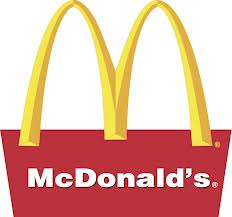

Executive Summary
McDonald’s Corporation is a “Centralized, International company”, which competes in the fast food industry supplying hamburgers, french fries and other consumable items using standardization, heavy expansion and branding as the driving force. McDonald’s operates in over 121 countries and has over 30,000 restaurants worldwide.
McDonald’s utilized an intense, rapid expansion into foreign countries through three primary methods, franchising, company owned restaurants, and joint ventures. With the majority of international restaurants stemming from franchising agreements, McDonald’s management relied on this method to aid in the acceptance of a new style of eating into unfamiliar markets. With minimal risk and maximum gains, franchising continues to contribute heavily to McDonald’s international success.
With a centralized, international structure, McDonald’s keeps a tight grasp on operations, cost and quality. With an ethnocentric management strategy, McDonald’s relies on domestic based logic and attitudes and transfers them to their international outlets and restaurants.
In order to control its overseas operation, McDonald’s uses a combination of two approaches. The majority of control would fall under the rules approach, meaning that control lies with headquarters creating procedures and policies for the subsidiaries to follow. However, there is also a little of the cultural approach that has surfaced and is being utilized judging by the adaptation that has occurred in some of the overseas restaurants. This has occurred even with the tight internalized norms that are constantly presented and enforced by headquarters.
McDonald’s Background

With operations in over 121 countries and over 30,000 restaurants around the globe, McDonald’s Corporation is the largest fast food service and supplier in the world. To serve all of the their customers and demonstrate the incredible size of the company, McDonald’s has more than one and a half million employees and serves more than ninety-six percent of the world’s population at least once a year. McDonald’s operates in the fast food industry and its core product lines include hamburgers and french fries, but the chain also sells chicken, salads, and fish products among others.
Since the first restaurant operations in the early nineteen fifties, McDonald’s has grown at an incredible pace through an internal philosophy of “expand at all costs.” What this philosophy means is open as many stores as possible as fast as possible. At the peak of the company’s growth, this rapid pace had a new McDonald’s outlet opening every four hours everyday of the year. Management instilled the idea that as more restaurant locations are opened the more customers will be served, and this leads to higher profits that would be realized across the board. Since the beginning, this intense expansion plan has been successful, both in the domestic and foreign markets abroad. However, recently there have been issues developing with saturation across the globe that have had an impact on sales, which will be discussed later in the paper.
The company has always utilized four major principles throughout its history to expand rapidly, increase sales and remain the market leader. By leveraging their enormous cash flow, brand power, real estate and customer spending habits, McDonald’s has not only emerged as the world-wide leader, it has also changed the way the world eats. As the means to rapid expansion are not the focus of this paper, altering the eating habits around the world represent a very significant topic and will also be addressed later in the paper.
International Operations Significance
McDonald’s first international expansion occurred in 1967 when the company opened in Canada. The company’s international division was formed shortly after in 1969 and has continuously grown since. Over the years, the international section of the McDonald’s Corporation has become increasingly more important to the company’s overall success. As of this past year, non-US based restaurants account for over half of the company’s $40 billion in revenues (Appendix A). Even more critical than the amount of sales to the company is the amount of profits of the overseas operations. Foreign restaurants now account for about 60% of McDonald’s total profits 4 . The difference between revenues and profits of international operations is credited to McDonald’s immense market share in off shore outlets. Currently, McDonald’s is the market leader in 96% of the markets they do business in around the world and it is very common for McDonald’s to hold over 50% of the fast food market in foreign markets. Unlike the U.S., competitors in the past have not cut into McDonald’s market share as easily in foreign markets, although that is beginning to change.
There are a few major reasons why McDonald’s not only chose to invest overseas originally, but also continuously since. In the last ten years, almost 90% of McDonalds’ expansion occurred in countries other than the United States. During that time, the 1990’s saw an increase in international units from 3,600 in 1991 to more than 11,000 by 1998, largely in Japan, Canada, Germany, Great Britain, Australia, and France. Additionally, the number of international countries nearly doubled from 59 in 1991 to 114 in 1998 (Appendix B). The rationale behind these important decisions stemmed foremost from the increasing amount of saturation that had evolved in the United States. This saturation was in the past, and is currently, forcing McDonald’s to slash prices and as a result profits in its domestic market. To counter this trend, international restaurants were franchised and invested in. As was mentioned earlier, foreign markets are extremely more profitable for McDonald’s than U.S. operations. McDonald’s detected this trend early as an opportunity through marketing research and the idea of utilizing the heavily populated areas of focus to cut costs and increase profits. Second, expansion in the U.S. has been taking place for the last 45 years, where it has only been occurring heavily overseas for about 20 years, so there is more business opportunity. McDonald’s serves over 43 million people a day, but that is still less than one percent of the world’s population, so you can see how McDonald’s management could be so optimistic.
To reiterate the importance of McDonald’s international restaurants to the overall core business plan of McDonald’s, a closer look at a few facts is required. First, the busiest McDonald’s in the world is located in Pushkin Square in Moscow. The restaurant serves over 43,000 customers a day and is only one example of the volume that some of the larger foreign restaurants are capable of. In fact, eight of the ten largest McDonald’s outlets in the world are located outside of the United States .
International Expansion through Franchising
Now that the international operations have been conveyed as an increasingly important part of McDonald’s overall sales, it is vital to analyze how McDonald’s entered into the foreign markets. McDonald’s entered into the international markets utilizing three methods; franchising, joint ventures and company owned outlets. Where McDonald’s had a choice, franchising was not only favored, it dominated how the company expanded. Currently, 73% of all McDonald’s restaurants across the globe are franchised 16 . When entering into some of the countries, McDonald’s had to abandon its philosophy of franchising and use the other methods. For instance, when McDonald’s first entered into Mexico, the government did not allow franchising from foreign countries. To work around this, McDonald’s utilized company owned restaurants to enter the market until the laws changed. In 1990, when the legislation went through legalizing franchising, McDonald’s Corporation sold the company owned outlets to franchisees. Similarly, joint ventures were used as an early entry method where franchising was not feasible. Although this option was not McDonald’s first priority, it was not a far second behind franchising, and the company’s most prosperous international success to date stems from an initial joint venture in Japan.
To grasp a better understanding of how important franchising was to McDonald’s rapid international growth, the very concept of franchising must be analyzed. McDonald’s restaurants have crossed international borders fairly easily compared to other retail sectors and it is attributed directly to franchising. However, the idea of franchising was not a new one to McDonald’s. In fact, McDonald’s expansion in the United States began very early in the company’s first years utilizing a method that was relatively new to the industry, franchising 5 .
It was the fast food industry, and McDonald’s specifically, that turned franchising into a business model that would transform the retail economy of the world. At the heart of a franchise arrangement is the desire by two parties to make money while avoiding risk. The franchiser wants to expand an existing business without spending its own funds. The franchisee wants to run a business without going at it alone and risking everything on a new idea. One provides a brand name, a business plan, expertise, and access to equipment and supplies. The other puts up the money and does the work 10 . In the case of McDonald’s, they wanted an international presence without the incredible risk associated with entering foreign countries and altering eating habits. McDonald’s knew that entering into foreign markets would be very difficult for an American fast food company and needed the aid of local partners to ease the transition. That is exactly what franchising allowed McDonald’s to accomplish. By franchising, McDonald’s could be marketed as a local country business instead of an American company strong-arming their way in. What they had to offer was the fastest growing fast food business in the world. Not to mention an extensive supplier line, industry leading technology and a very prosperous business history for anyone willing to accept the terms and pay the franchising fees.
Administrative Heritage
When comparing and contrasting the past and present organizational history of McDonald’s, the reflection in a mirror becomes top of mind. McDonald’s is one of the world’s most insular large companies, with a management team more typical of a private company than a global powerhouse. The average top executive started working at the company when Richard Nixon was President and there are no future plans to shuffle top management. The 15-member board of directors has avoided the corporate-governance revolution that has attacked a large majority of the Fortune 500 companies. By adding directors who do not have a direct stake in the company, share holders, consumers, and employees can be reassured that actions made are for the good of the company. However, McDonald’s has elected not to take part in this trend. Currently, more than two thirds of the board of directors is filled with current and former executives, vendors, and service providers 4 .
McDonald’s has basically been the same for fifty years, and change does not seem to be a top priority. The company focus has always been publicly stated as being directed to McDonald’s customers and employees, although both have been debated extensively over the years. One topic that has remained constant throughout the company’s history is the emphasis on management training. Management centers are now located in Munich, Tokyo, Sydney and London where professors instruct management students in 22 languages. These centers are replicas of the Hamburger University that has become famous in the United States, not only for the information taught, but also for the large number of managers that have been trained at the facilities.
McDonald’s Structure and Strategy
McDonald’s is a “centralized, International Division” company composed of franchisees and joint venture partners. McDonald’s utilizes a broad approach and initially grew overseas by relying on transferring new products, processes, and strategies from the United States to less developed markets 1 . The idea has always been to transfer the American tradition of fast food to other counties using the same real estate principles, cost advantages, and new technologies that were so successful in the U.S. McDonald’s has always exploited the corporate company knowledge and transported and diffused it to foreign markets. Starting with the concrete supplier chain, all the way down to the store design and implementation, differentiation is not encouraged nor is it allowed.
With an Ethnocentric mentality, McDonald’s has constantly based the companies international operations on “home-grown” ideas and concepts. Corporate first places the focus the domestic market, and then filters the functions to the overseas operations. Information flows from corporate to the franchisees based on what is working in the United States markets, with the expectation that it will be implemented in the foreign markets. When analyzing McDonald’s corporate structure (Appendix C), it is evident that the top down approach is not only used it is enforced. All information starts with corporate and is disbursed to the foreign markets.
Company Control and Coordination
In order to control the thousands of franchises in the system, McDonald’s corporate utilizes a combination of methods. Both the Rules Approach and the Cultural Approach are applied by management in order to ensure that the international outlets maximize their potential without disrupting the overall corporate plan. The reason for the combination of control approaches stems from the nature of how the McDonald’s system was built. By relying and building around franchising, a fine line has to be drawn between keeping the franchises motivated and accomplishing the company objectives.
The elements of the Rules approach are very evident when magnifying the requirements of the franchisees. Management requires continuous lines of reports and paperwork to follow every move of the franchises. The extent of the requirements can be seen in the following example. The McDonald’s operation-and-training manual is a roughly seven hundred and fifty-page document that weighs about four pounds. It is known throughout the company as “the Bible” and contains precise instructions on how various appliances should be used, how each item on the menu should look, and how employees should greet the customers. An example of the extent of detail that is contained in the manual are hamburgers are always to be placed on the grill in six neat rows; french fries have to be exactly 0.28 inches thick. The regimentation and standardization of McDonald’s restaurants determines exactly how every task is done and imposes rules about pace, quality and technique. The McDonald’s Corporation insists that its operators follow directives on food preparation, purchasing, store design and countless other minute details. Operators who disobey these rules can lose their franchises and this has occurred in the past.
The control from corporate can be extensive at times and franchises are constantly threatened. “We have found out…that we cannot trust some people, who are nonconformists,” declared Ray Kroc, one of the founders of McDonald’s, angered by some of his franchisees. “We will make conformists out of them in a hurry…The organization cannot trust the individual; the individual must trust the organization…” 4,10 From the beginning of time, McDonald’s management has created and pushed an operating system of unusual thoroughness and attention to detail. In order to enforce this style of management, McDonald’s has strategically placed local and regional offices throughout the world (Appendix D).
As mentioned before, the nature of franchising has led to this pattern of control and further discussion on the topic is warranted to clarify it. The franchising relationship has its built-in tensions. The franchiser gives up some control by not wholly owning each operation and the franchisee sacrifices a great deal of independence by obeying the company rules. Everyone is happy when the company is succeeding and profits are rolling in, but when revenues fall, the arrangement often degenerates into a mismatched battle for power. The franchiser almost always wins. In the global world of McDonald’s, that exact scenario is currently taking place. The last three years, McDonald’s has seen lagging sales in the domestic market and booming sales in the international markets. As a result, corporate is trying to tighten the reigns on foreign operations even tighter than they have in the past 10 . The key to a successful franchise, according to many texts on the subject, can be expressed in a single word: uniformity. Franchises must reliably offer the same product or service at numerous locations. This is the case with McDonald’s. They must continue to provide a high quality core product line at the lowest possible cost available. Customers are drawn to familiar brands by an instinct to avoid the unknown. A brand offers a feeling of reassurance when its products are always and everywhere the same. At the same time, a little control must be sacrificed to keep motivation and creativity among the franchises blossoming. This concept is why McDonald’s management also utilizes some of the Cultural Approach to control the international markets.
Through the years, McDonald’s management has realized that in the fast food industry, more freedom is needed in order to prosper in foreign countries. There are two major business functions that are dictated by the country’s local influence and symbolize the Cultural Approach freedom; product development and marketing. These functions are not only locally developed they are operational away from headquarters and are represented in McDonald’s structure chart accordingly (Appendix C). By allowing the foreign markets the autonomy to develop and market geographical specific menu items, management is not compromising or deviating from internalized company norms or standards. Instead, they are allowing for local adaptation that will not only benefit the franchise, but the corporation as well. Both product development and marketing will be discussed in detail below.
Product Development and Marketing
As mentioned previously, product development and marketing can and do occur at a local level in McDonald’s international countries. These are the only two major business functions that McDonald’s Corporate allows some flexibility by deviating from the tight grasp that they hold over international restaurants. Now, that is not to say that the countries and local markets have complete freedom to add to the menu and promote their products how they wish. McDonald’s prides itself in the consistency of its products and taste around the world and would not allow complete autonomy. Instead, it means that some of the lengthy, tedious, and idea crushing control that corporate normally holds over its franchises is lifted slightly and can occur at the country level as opposed to corporate level (Appendix C). To look at the impact this has on the international outlets, a closer look at product development and marketing will each be analyzed.
Each local country has the autonomy and authority to develop its own products to address unique tastes that their consumers have. It is the sole responsibility of the individual country to complete the marketing research and develop new menu items. Once that has occurred, the information is then studied and approved or rejected by the corporate offices depending on the extent of favorable data available. Where there is limited involvement from corporate in the development process, there is still heavy involvement in the acceptance process. This involvement from corporate is only increasing, as the international markets become more important to McDonald’s overall business. However, according to Den Fujita, President of McDonald’s Japan, when McDonald’s first entered Japan, corporate was relatively accommodating to the new menu items that were presented to them, and as a result, acceptance in Japan was expedited 5 .
There are many examples of item adjustments that have been made around the world over the years to address local tastes and preferences (Appendix E). The menu changes resulted from many different reasons such as cultural, religious, taste preferences and translation reasons. Some specific examples are in India, there are no beef items served throughout the country, so McDonald’s added the “Maharaja Mac”, a lamb version of the standard “Big Mac”. Other examples include Germany, where McDonald’s serves beer with meals and in Cyprus, the McNistisima menu was adopted for the lent period between Easter and Christmas and consisted of veggie burgers, country potatoes, and shrimp and spicy rolls 14,16 . Occasionally, new local menu items might not seem like a logical choice for a country and are protested accordingly like when McDonald’s was going to recently add meat bowls over rice. Heavy protesting occurred until the launch of the items. However, on the first day the bowls were available, they sold out entirely proving that local marketing research and flexibility can benefit the company 13 .
The marketing of international restaurants is handled with the same process as product development. Locally, the countries develop and test market ideas that differ from the corporate worldwide message. Any differences in the core message are then presented to the corporate office for approval. Marketing overseas, like product development, is mostly handled away from the corporate office. There are many reasons why the core marketing message would change, including; translation reasons, cultural differences, customer target differences and the fact that the product itself being marketed might not even exist in the company’s core message. A specific example of a country differing the marketing message from corporate took place in different countries that use the metric system. Instead of calling their burger the “Quarter Pounder”, the European countries market their burger as either the “Royal Hamburger” or the “Burger Royal.”
Future Issues for McDonald’s
In order for the international division of McDonald’s to continue the impressive success that it has achieved in the past, two major areas of concern must be addressed. The increasing level of saturation in most of the major markets around the world and the struggle over autonomy between corporate and the franchises must be addressed with extreme urgency and by allocating the resources necessary.
As mentioned earlier, competition in the fast food industry is becoming incredibly saturated. When McDonald’s first began expanding into international markets, their main focus was altering eating habits. This was primarily because there was an absence of major competitors overseas. However, over the last decade, the international market is beginning to mirror that of the heavily saturated United States market. Profits are shrinking, same store sales are down, and the overall market growth has slowed tremendously. This has prompted McDonald’s to continue to cut costs by announcing the closing of 175 under performing outlets in 10 countries. As the international markets become more competitive and saturated, McDonald’s must continue to analyze and make adjustments accordingly.
Although saturation is a growing issue overseas, it was noted earlier that foreign operations are now more than ever, a major element of the McDonald’s Corporation business. As a result there is a constant battle over autonomy. The franchises, especially the experienced outlets with over a decade of success, want more autonomy to adapt to local tastes and preferences. The franchises feel that as the market becomes more competitive, it will be vital for alterations and adaptations to occur faster and easier than they ever have in the past. However, McDonald’s corporate is on the opposite side of the issue and is not budging. Corporate feels that control must be at an all time high because of the importance of the international division and the fact that if it fails, the whole company could suffer as a result. Corporate has tightened the reigns consistently the last few years and will continue to do so to stay afloat by turning the losses into gains.

Handicraft Business in Bangladesh

Discuss on MEP Design or MEP Detailing

Assignment on Marketing System of NCC Bank Limited

Report on Effectiveness of Internal Communication (Part-1)

Annual Report 2009-2010 of Sun Pharmaceutical Industries Limited
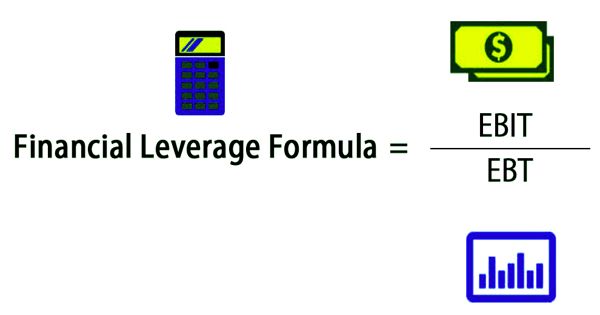
Degree of Financial Leverage (DFL)

HRM Practice in Dhaka Sheraton Hotel

Snowflake Symmetry

Gastric Bypass has Short-lived Positive Metabolic Effects
Latest post.

Bismuth Chloride – an inorganic compound

Bismuth Iodate – an inorganic compound

In Mice, a special mechanism shields Pancreatic Cells against Inflammation

New Perspectives on how Bird Flu overcomes the Species Barrier

Bismuth Hydroxide

Rubidium Fluoride (RbF)

- About / Contact
- Privacy Policy
- Alphabetical List of Companies
- Business Analysis Topics
McDonald’s Operations Management: 10 Critical Decisions, Productivity
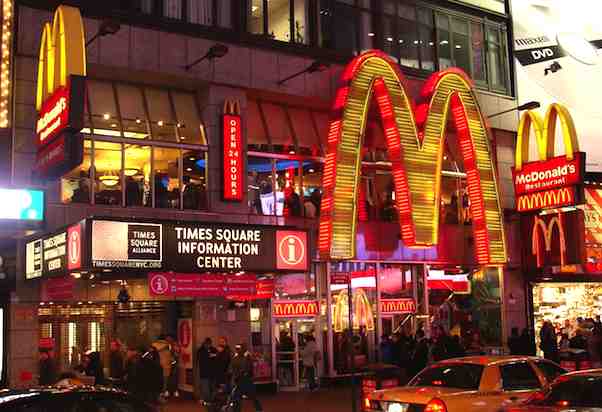
McDonald’s operations management (OM) supports the company’s position as the largest fast-food restaurant chain in the world. The business implements solutions pertaining to the 10 decision areas of operations management, such as supply chain management for the movement of ingredients. In these 10 strategic decisions, McDonald’s aims for maximum operating efficiency and productivity to facilitate business strategies that rely on low production costs. For instance, in process and capacity design, which is a part of operations management, the food service company optimizes production processes to minimize costs and enable competitive selling prices. In this regard, operations management effectiveness impacts how the goals of McDonald’s mission statement and vision statement are achieved. Operations strategy and related strategic planning determine the restaurant corporation’s overall business performance.
With the 10 decisions of operations management, McDonald’s optimizes the business to counteract competition. The company competes with Wendy’s , KFC, Dunkin’, Burger King , Subway, and Arby’s. McCafé operations also compete with Starbucks and Tim Hortons, as well as some PepsiCo beverages and Unilever ’s Bru coffee, which can be purchased online in various countries. The Five Forces analysis of McDonald’s Corporation shows that these competing firms impose a strong competitive force, which influences the company’s operations strategy and measures for optimal productivity.
McDonald’s Operations Management: 10 Critical Decision Areas
1. In the design of goods and services , the objective is to develop the best product, given the resources and limitations of the fast-food company. In this case, McDonald’s aims for high efficiency of service operations, and the standardization of goods. High efficiency and productivity in food preparation minimizes production costs. On the other hand, standardization of goods contributes to menu and product consistency and customer satisfaction at store locations. In this strategic decision area of operations management, managers are concerned with satisfying the general public, which is the target market based on McDonald’s generic strategy for competitive advantage and strategies for intensive growth . The company aims to attract everyone to its fast-food restaurants. Also, in making product design decisions, operations managers account for the product element of McDonald’s marketing mix or 4P . Thus, the strategies and tactics in the fast-food company’s marketing mix relate to this strategic decision area of operations management.
2. Quality management involves matching McDonald’s food, drinks, and service to the quality expectations and preferences of target consumers. The operations strategy applies policies and measures to ensure that such matching is achieved at company-owned, franchised, and licensed locations. Product standardization comes with quality consistency, which contributes to the business strengths identified in the SWOT analysis of McDonald’s Corporation . Such quality consistency helps the fast-food business satisfy consumers’ expectations. However, McDonald’s operations management faces the challenge of maintaining satisfactory quality despite cost minimization, which is essential for competitive selling prices.
3. Process and capacity design is a decision area that pushes operations management to optimize production processes, such as the production of intermediate ingredients used to make burgers and fried chicken. McDonald’s operations strategy maximizes the benefits of economies of scale in production processes, in order to support competitive pricing. For example, the company employs custom equipment for large-scale and high-speed food preparation. In this way, operations management achieves high efficiency in production processes and the minimization of costs at corporate facilities, hubs, and restaurants. Also, the production line method maximizes productivity and capacity utilization at McDonald’s restaurants.
4. For its location strategy , McDonald’s has various facilities that support its operations. The operations management objective in this strategic decision area is to establish and maintain locations that optimally account for access to target consumers, access to resources, the supply chain, costs, productivity, and economic variables. For example, McDonald’s production facility locations satisfy restaurants’ supply requirements. Also, company-owned, franchised, and licensed locations are established for maximum market reach. In this decision area, McDonald’s operations management involves restaurants, kiosks, and the company’s websites and mobile apps as venues. Other locations considered are those of third-party distributors or retailers of McCafé products, such as Walmart , Costco , Amazon , and Target. Through these locations or venues, the global fast-food restaurant chain reaches customers in traditional and online ways. Also, McDonald’s business structure (company structure) determines the locations of facilities and resources, including human resources.
5. Layout design and strategy aim for high efficiency in moving resources and information throughout McDonald’s business organization. For the movement of information at the fast-food company’s offices and other locations, information technology offers high efficiency with minimal drawbacks. On the other hand, at restaurants and kiosks, McDonald’s operations strategy involves layouts that maximize space utilization and productivity, rather than comfort and spaciousness. For example, kitchens are designed to match steps in food preparation. Also, many small tables are arranged to accommodate large numbers of diners at the restaurants.
6. In human resources and job design , operations management has the objective of developing and maintaining an adequate workforce for McDonald’s business development. The multinational corporation supports the staffing needs of its restaurants. For example, the company has standardized training programs for skills needed in food production and preparation. This support is in addition to the human resource policies and measures that McDonald’s franchisees and licensees implement on their own. For this decision area of operations management, individual and organizational learning are also emphasized throughout the fast-food restaurant chain. McDonald’s organizational culture or corporate culture influences human resource management programs to facilitate such learning.
7. Supply chain management aims to maintain high effectiveness and operating efficiency throughout McDonald’s supply chain. The food service company’s operations management uses information technology to inform suppliers and enable them to match their operations to the company’s supply needs. McDonald’s has a mixture of regional suppliers for highly standardized ingredients, and local suppliers for perishables. In this context, suppliers’ productivity affects the restaurant company’s productivity. With this consideration, McDonald’s corporate social responsibility (CSR), ESG, and stakeholder management strategy and other business strategies impose policies and rules for suppliers, to minimize disruptions in the supply chain.
8. In inventory management , McDonald’s operations management objective is to ensure adequate inventory for smooth business operations with minimal disruptions in resource availability. This decision area of operations management functions as an interface between the supply chain and the rest of the food service organization. Materials from suppliers pass through inventory management, or are stored for later use, depending on the requirements of the corporation and its restaurants. Inventory management effectiveness influences productivity at store locations. In this regard, McDonald’s minimizes inventory costs while supporting restaurant operations.
9. Scheduling at McDonald’s follows industry best practices, with considerations for supply chain capabilities, market conditions, and regulations. The strategic objective in this decision area of operations management is to apply schedules so that resources and assets are utilized to their full potential, while the fast-food chain satisfies its target customers. Regular schedules are used for McDonald’s corporate offices and restaurant locations. Also, seasonal schedules may be applied to support operations during spikes in market demand for fast food. Operational effectiveness is achieved by matching the schedules to the requirements of McDonald’s and its partners.
10. In maintenance , strategic decisions focus on maintaining stable operations, which relate to the stability of operations at the company’s corporate offices and stores. To maintain high productivity, McDonald’s operations management monitors the needs of its restaurants, and uses the resulting data to inform maintenance teams. Third-party service providers are also used in some situations, such as for the repair of cooking equipment and machinery. At McDonald’s hubs for material distribution, maintenance is implemented in terms of matching operational capacity and human resources to the current needs of the business organization. In this context, operations management also uses real-time monitoring and control to ensure that decisions and actions correspond to the current conditions of the food-service company. Considering the international scope of the business, the global, regional, and local trends characterized in the PESTEL/PESTLE analysis of McDonald’s Corporation influence the maintenance requirements and the tools available to maintain stable operations and high productivity.
Productivity at McDonald’s
With regard to the 10 strategic decisions of operations management, McDonald’s works toward maximum productivity in all its business areas. The following productivity metrics are some of the criteria applicable to McDonald’s operations management:
- Order fulfillment rate (productivity at McDonald’s restaurants)
- Stockout rate (productivity of inventory management, hubs, warehouses, and distribution facilities)
- Timely delivery rate (productivity of deliveries, including third-party delivery services)
- Akkaş, A., & Gaur, V. (2022). Reducing food waste: An operations management research agenda. Manufacturing & Service Operations Management, 24 (3), 1261-1885.
- Alexander, T. (2023). Unwrapping the McDonald’s model: An introduction to dynamic social theory. The Journal of American Culture, 46 (3), 232-241.
- Amirul, S. R., Pazim, K. H., Amirul, S. M., Mail, R., & Dasan, J. (2022). Developing and validating the qualitative labour productivity measurement in service industry. Quality & Quantity, 56 (4), 2853-2874.
- McDonald’s Corporation – Food Quality & Sourcing .
- McDonald’s Corporation – Form 10-K .
- McDonald’s Corporation – Our Commitment to Quality .
- McDonald’s Corporation – Where We Operate .
- McDonald’s History .
- Veiga, G. L., Pinheiro de Lima, E., & Gouvea da Costa, S. E. (2022). An efficiency-frontier based procedure to improve operations strategy. Journal of Industrial Integration and Management, 7 (03), 367-399.
- Zhou, L., Jiang, Z., Geng, N., Niu, Y., Cui, F., Liu, K., & Qi, N. (2022). Production and operations management for intelligent manufacturing: A systematic literature review. International Journal of Production Research, 60 (2), 808-846.
- Copyright by Panmore Institute - All rights reserved.
- This article may not be reproduced, distributed, or mirrored without written permission from Panmore Institute and its author/s.
- Educators, Researchers, and Students: You are permitted to quote or paraphrase parts of this article (not the entire article) for educational or research purposes, as long as the article is properly cited and referenced together with its URL/link.
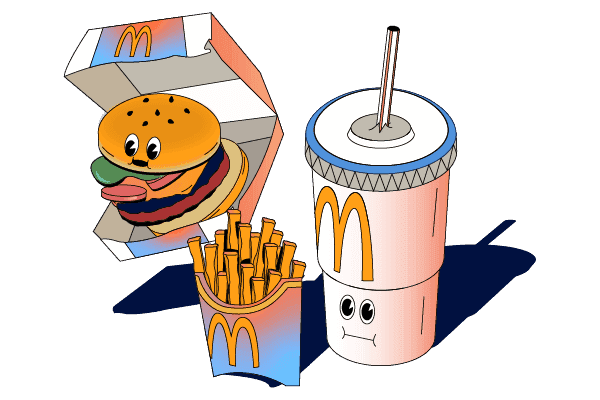
McDonald's Marketing Strategy: The Rise Of The Golden Arches (+4 Key Strategies)
Golden arches, golden nuggets, crispy fries, ice-cold Coke — I’m loving it.
No don’t worry, this piece isn’t an ad for McDonald’s. Instead, we’ll be exploring how a single California-based burger joint grew over the span of the past 80 years into the worldwide phenomenon that it is today.
We’ll dive into the history behind the iconic McDonald’s brand, what strategies have set Ronald’s Palace apart from its competition, and what marketers can learn from the effectiveness of McDonald’s marketing strategy. But first…
Claim Your Marketing Strategy Templates Bundle
This collection of templates will help you plan and execute an excellent marketing strategy that your entire team can believe in.
McDonald’s History: The Rise Of The Golden Arches
McDonald’s has grown a massive brand on the back of some powerful marketing initiatives and is now the 9th highest-value brand in the world .
The founding of this groundbreaking restaurant chain, however, was nothing special.
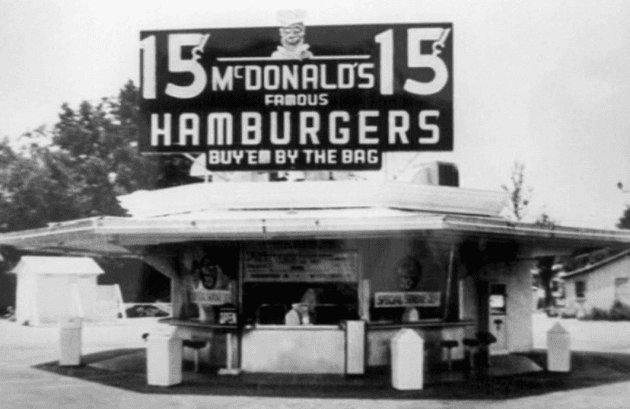
Richard and Maurice McDonald opened the original McDonald’s restaurant in 1940 in San Bernardino, California. There, the brothers created the Speedee Service System, which allowed them to cut down prep time on their food from around 20 minutes to under one minute.
By focusing on a limited menu—burgers, fries, shakes, and beverages—the brothers were able to create an incredibly effective operation with high-quality food and service.
The brothers looked to capitalize on their initial success with this new “fast-food” concept and hired Ray Kroc as their franchise agent. Soon, Kroc would be opening new restaurants across the country, and in 1961 he purchased the rights to McDonald’s from the McDonald brothers.
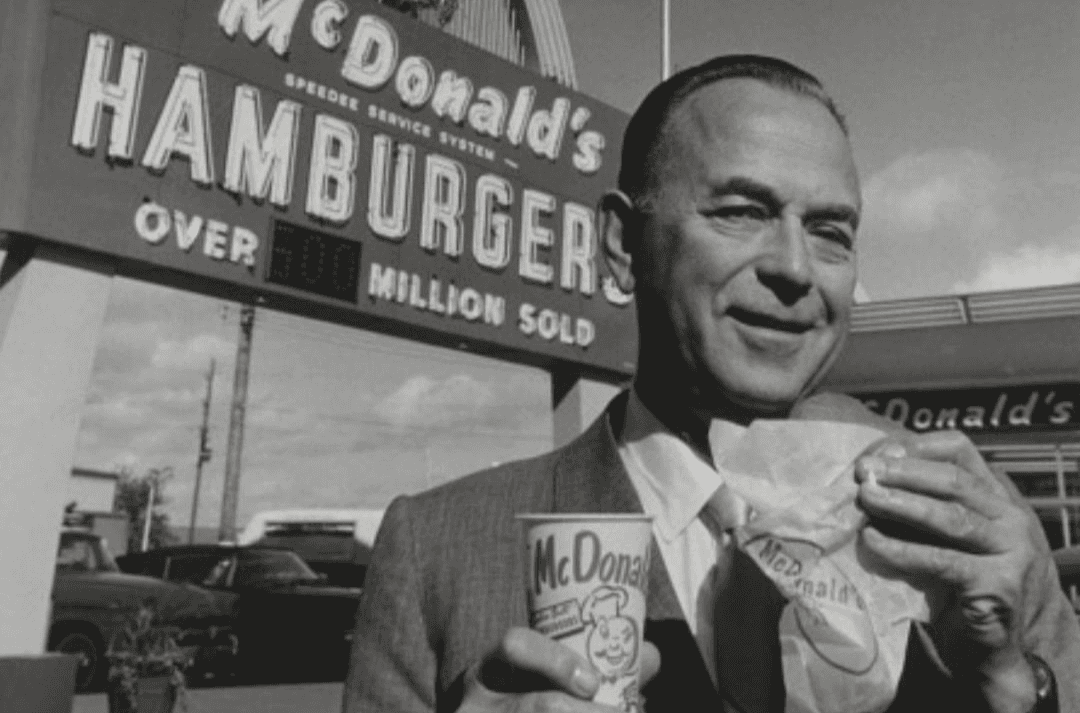
From this point on, McDonald’s grew rapidly. In 1957, McDonald’s had 40 stores pulling in upwards of $3 million per year. By the 1960s, there were roughly 1,000 McDonald’s franchises in the US.
Today, the company pulls in more than $20 billion in revenue on a yearly basis, and there are currently 39,198 independently owned and operated McDonald’s franchises across the world.
This sort of immense business growth didn’t come from nowhere.
McDonald’s History: Hot Dog Stand To Multinational Brand
- 1940: McDonald brothers open their first restaurant in San Bernardino
- 1948: The brothers implement the Speedee Service System, modeled after Henry Ford’s assembly lines
- 1953: McDonald’s opens its first franchise restaurant in Phoenix
- 1954: Ray Kroc joins the company
- 1961: Kroc buys out the McDonald brothers
- 1962/63: McDonald’s launches the golden arches and Ronald McDonald
- 1963: Ronald McDonald takes center stage in McDonald’s first TV commercial
- 1967: Kroc takes over as CEO
- 1967: McDonald’s opens its first international restaurant in Canada
- 1974: Ronald McDonald House charity opens
- 1979: The Happy Meal launches
- 1988-1996: The company doubles its number of restaurants, opening restaurant #20,000 in ‘96
- 2000: McDonald’s has opened more than 11,000 restaurants outside of the US
- 2003: “I’m Lovin’ It” marketing campaign launches
- 2004: “Super Size Me” documentary is released
- 2006: McDonald’s begins offering nutrition information for all menu items
- 2015: All-day breakfast launches
- 2018: Announces goal to have all packaging come from renewable sources by 2025
The Ideas That Built Success: Values & Standards
The first big idea that Kroc used to grow McDonald’s was consistency—he envisioned a restaurant serving food that tasted the same in Alaska as in Alabama.
Kroc also believed in four core values of the McDonald’s brand: quality, service, cleanliness, and value.
“If I had a brick for every time I’ve repeated the phrase Quality, Service, Cleanliness, and Value, I think I’d probably be able to bridge the Atlantic Ocean with them.” – Ray Kroc
These values were then supported by the three primary pillars of McDonald’s success: franchisees, suppliers, and employees.
Franchisees are required to undergo extensive training at McDonald’s “Hamburger Academy,” where they learn how to uphold McDonald’s core values in their individual franchises.
Suppliers are carefully selected to uphold quality ingredients, and McDonald’s prides itself on utilizing local and regional farms and supply lines to keep their food fresh and support the areas their restaurants are based in.
Finally, while McDonald’s employees are at times the punching bag of jokes in popular culture, they are valuable assets within this system envisioned by Kroc. The company often helps struggling employees get back on their feet. As former McDonald’s employee James Franco once said , “All I know is that when I needed McDonald’s, McDonald’s was there for me. When no one else was.”
If you’ve ever been desperate for a cheap meal late at night, you probably feel a similar sentiment.
4 Marketing Strategies That Made McDonald’s Massive Brand
So, what exactly did McDonald’s do differently that set them apart from the rest of the fast-food marketplace?
1. Implemented A Case-Study-Worthy Franchising Model
While fairly commonplace today, McDonald’s franchising model was one of the first of its kind and is the model many companies try to replicate.
This worked for two reasons: First, McDonald’s invested a ton of money into ensuring that there was consistent quality across its franchises. Second, the company invested in sourcing products from individual regions, and tailored menus to match regional tastes.
By sticking with its main tenets (quality, service, cleanliness, and value) and incorporating localized ingredients and tastes into regional menus, McDonald’s has been able to grow with expanding markets and ensure its franchisees see success in any locality.
2. Invested Massive Amounts In Marketing To All Ages
As a fast-food restaurant, it can be hard to pin down a specific target audience. That’s why McDonald’s has, since the start, looked to find ways to market themselves as a great option for all ages, i.e. “the entire family.”
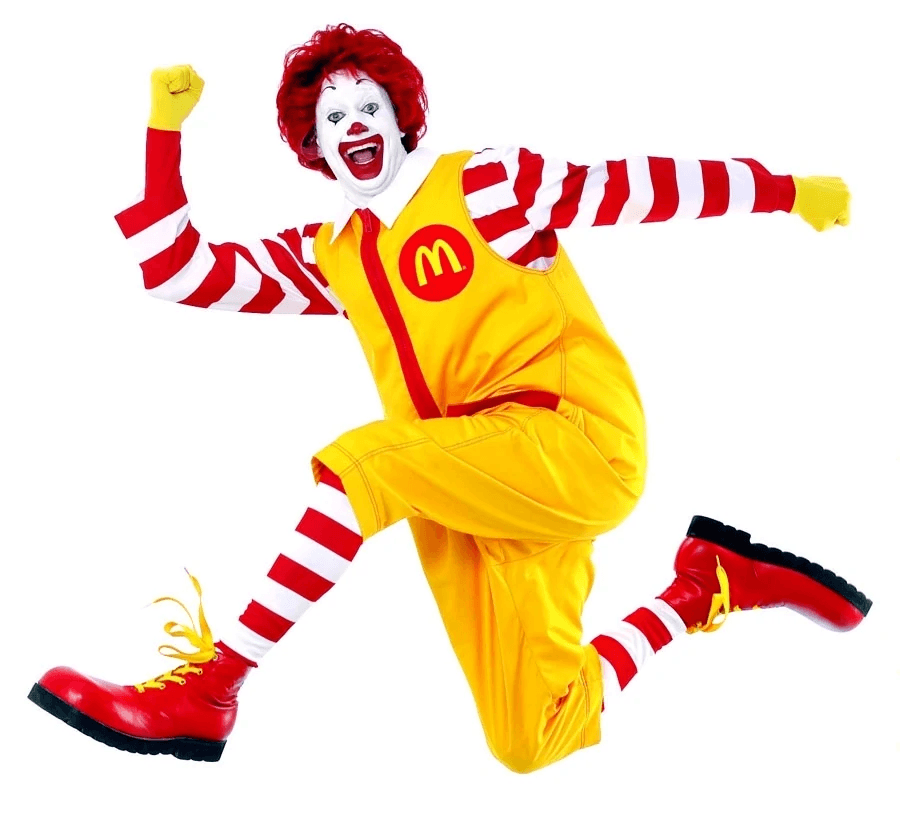
Options like the Happy Meal alongside bigger packages and portion sizes make it easy for anyone who is hungry to turn to McDonald’s as a solution, big or small.
3. Doubled Down On Core Products
Another driver of McDonald’s continued success is its commitment to its core product offerings.
This trend started way back with the original McDonald brothers, who served an extremely limited menu so they could create high-quality products and quick service times for all of their products.
4. Made Changes To Meet Customer Demands
A major turning point for McDonald’s was the release of “ Super Size Me ,” which opened many people’s eyes to the damaging effects of a diet relying on processed food like McDonald’s.
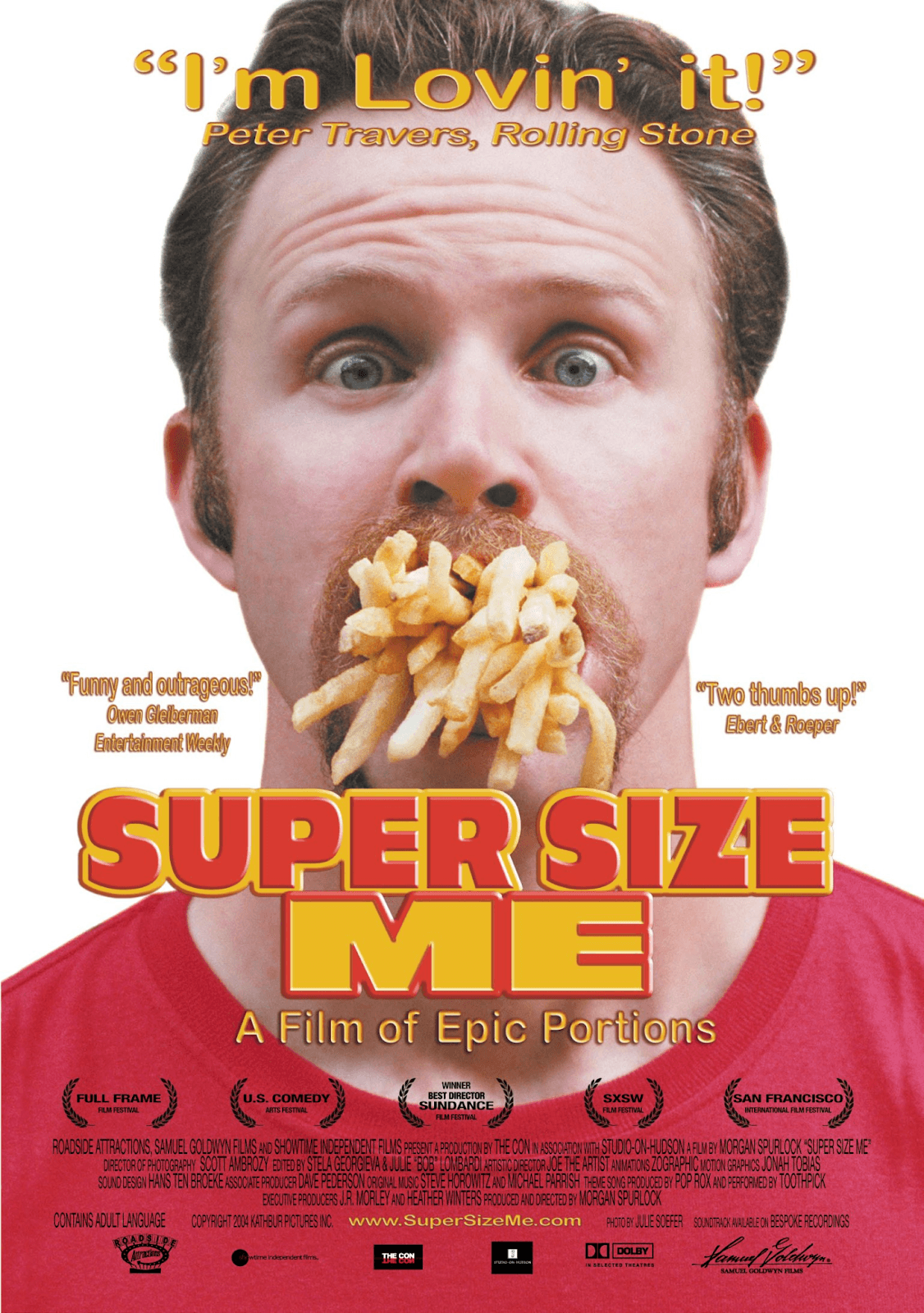
In response to this major PR issue McDonald’s expanded its menu to include more health-conscious options. The company began publishing nutrition information on its menu and products.
McDonald’s Marketing Mix
Want a more old-school breakdown? Here’s the 4 Ps of McDonald’s marketing strategy .
McDonald’s offers a variety of fast-food options including classic American staples (burgers & fries), an extensive selection of sweets and drinks (McCafe), McDonald’s-specific favorites (Big Mac, Quarter Pounder).
McDonald’s uses a value-based pricing strategy and strives to provide value to its customers across the menu, and also offers a $1-3 menu. In essence, their goal is to keep prices as low as possible.
Under McDonald’s franchising model, you’re able to find a restaurant near you almost anywhere you are.
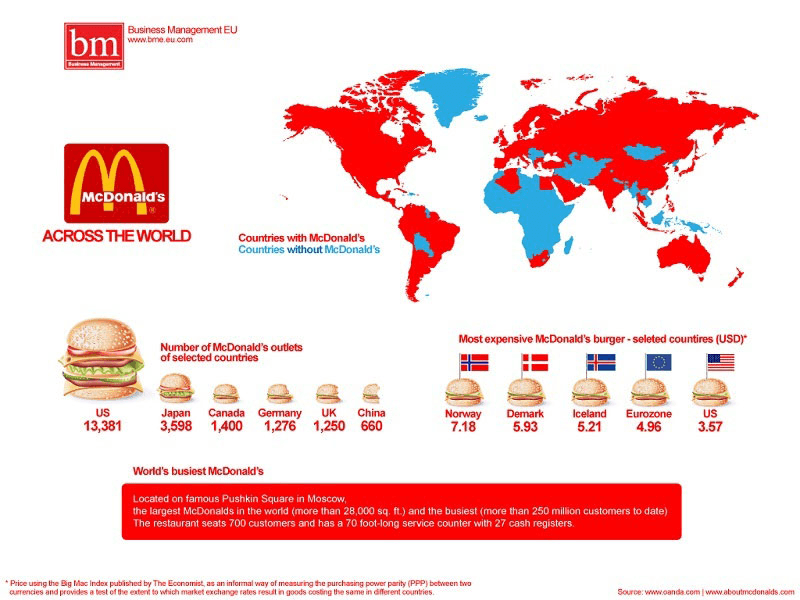
Additionally, the company is investing in delivery options with Uber Eats, Doordash, and other delivery services.
McDonald’s has invested unbelievable amounts of money into advertising efforts that span from traditional TV and radio to social media, guerilla marketing, and everything in between. These promotions center around McDonald’s as a great restaurant option for the whole family.
4 Strategies To Steal From McDonald’s Marketing Successes
1. invest in core products.
A key reason McDonald’s has been able to grow and sustain its continued success is its focus on promoting and continuously improving its core product offerings. These include fan favorites like the Big Mac and its famous fries, to more up-and-coming products like chicken nuggets.
In fact, McDonald’s recently offered a 2 for $5 deal with four of its primary menu favorites (Big Mac, Quarter Pounder with Cheese, McNuggets, and Filet O’ Fish). This shows that the company is not only continuing to stick with its core products, it’s also actively looking for new opportunities to promote these products and keep customers interested in its menu.
How can you do this for your company? Identify the core products you offer—those that your customers come back time and again to get from you—and see if there are opportunities to promote them to a broader audience.
By investing marketing and development dollars into your core products, you can ensure your company will continue to see revenue from these products while you look to scale or develop new products.
2. Be Agile & Proactive When Responding To Customer Feedback
When McDonald’s faced a major backlash after the release of “ Super Size Me ,” the company moved swiftly to adjust their menu, marketing, and internal policies to meet customer demands of a healthier, more transparent eating experience.
In the social media environment most businesses operate within, agility is key. Keep your ear to the street (or in this case, your feed) and see what your customers and outsiders have to say about your company. There may be opportunities for improvement you’re missing out on.
3. Large Target Audience = Large Marketing Budget
McDonald’s brand identity is a fast and easy option for the entire family. With such a broad target audience, it is difficult to hone in on one particular audience and channel.
This is why McDonald’s invests so much money into advertising across a wide variety of channels.
What does this mean for your brand? Either lock in on your target audience , or start spreading your marketing budget around. At this point you can find which channels work best and invest in those more heavily, but if you’re trying to appeal to everyone you need to get in front of everyone.
4. Expand Into New Markets By Appealing To Geographical Preferences
If you want to grow your reach by expanding into new markets, you need to make sure that you make the necessary changes to your approach to appeal to that market.
For McDonald’s, this means sourcing local ingredients and adjusting menus to appeal to regional tastes . For your brand, this may mean changing your outreach efforts to meet cultural norms or creating content in multiple languages.
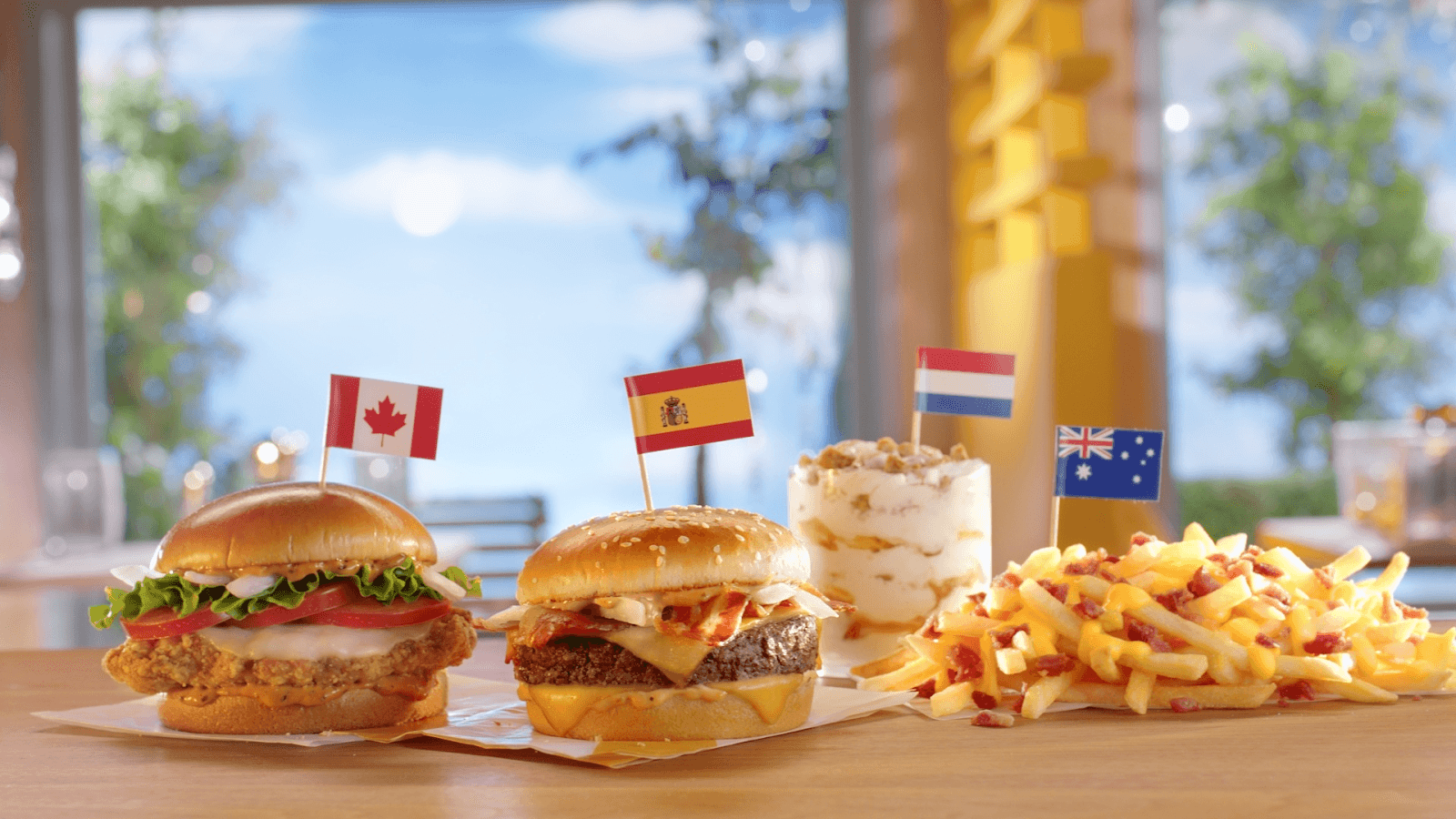
By doing so, you can break down the barriers between new markets and your product and begin building a dedicated customer base in those markets.
Powerful Marketing Strategies: I’m Lovin’ It
Now that you know the marketing strategies that made McDonald’s successful, go out and make them work for your brand.
Find your values, locate your core products, and invest time and money into improving and promoting them.
Table of Contents
Mcdonald's consumer profile, mcdonald's advertising strategy , promotion for broadcast, billboard ads, outdoor ambient marketing, mcdonald's digital marketing strategy, become a digital marketer in 2022, mcdonald's marketing strategy - a case study.

In 1940, California was where the first McDonald's opened. It became well-known quickly for its tasty hamburgers and friendly service. Eight years later, it was one of the first places to switch from traditional table service to fast food. It added new kinds of burgers and milkshakes to its menu. The success of the development led the company to sign its first franchise agreement in 1952, which led to rapid growth worldwide. The company runs about 40,031 restaurants worldwide, and sales in other countries brought in about $21.076 billion in 2019.
McDonald's marketing strategy has helped the company achieve the success it commands today. From the start of its growth, the company wanted to build strong brand recognition and market penetration to help promote its growing franchise business. As the company's number of customers grew, they did more research on demographics to help them target easily. McDonald's marketing strategy includes investing in online and offline marketing methods that spread its clear, brand-centered messages to a large audience and using other channels like its dedicated mobile app to reach and keep loyal customers.
Learn All the Tricks of the Marketing Trade
McDonald's has a wide range of customers because it uses mass marketing and has low prices at fast-food restaurants. Most of the chain's customers are between 35 and 54. Buyers, both men and women, often have low to average incomes. They are known as brand-loyal casual diners who spend an average of $7.79 each time they eat.
Many of these customers are parents of young children who like that the brand's atmosphere and food are good for families. This market group was first targeted in 1979 when Happy Meal, a set of children's meals with a free-themed toy, was introduced.
McDonald's website wants to create a "pleasant, entertaining environment for everyone to enjoy." This shows how many different kinds of people it wants to attract. The brand does primary market research to determine how to market itself and make sure it fits the demographics of the people it wants to reach. McDonald's uses surveys and questionnaires in stores, on social media, and through its mobile app to find out how happy customers are with the food, service, delivery, and other things. McDonald's Community and other digital channels are always being watched to keep track of what customers say and do.
McDonald's spends a lot of money on billboards and TV ads. In 2018, the company spent nearly $1.5 billion on advertising in the US alone. Outdoor, TV, and radio ads aren't likely to reach many people, so digital marketing strategies are used to send consistent information to people who aren't likely to see or hear the ads.
McDonald's marketing strategy uses TV and radio to get the word out about its brand and promote new menu items, meal discounts, and charitable work. Its broadcast channels and times are chosen so that most people will watch or listen. In November 2018, when the NFL season was at its peak popularity, McDonald's is expected to have spent $52.9 million on TV ads in the United States. This shows the importance of the fast-food chain getting the most prominent broadcast ad positions.
McDonald's has a lot of traditional billboard ads, which have the same marketing goals and content as its TV ads. With billboards that range from static to digitally interactive and are placed in high-visibility, high-traffic areas, the company tries to keep its target demographic and other connected consumer groups thinking positively about its brand.
This is a great example of how multiple ways to promote the same goals can make the campaign more successful compared to campaigns that only use one method.
McDonald's also does creative and interesting outdoor ambient marketing. Ambient advertising is when promotional materials are put in places or on things that are very unusual or unexpected or that aren't usually used for advertising. McDonald's is using this type of guerrilla marketing to make more of an impact on customers. McDonald's campaign shows this for its "Massive McMuffin Breakfast." During the whole year of 2010, the company put up big paper takeout bags with the name of its new breakfast item on major streets in New Zealand. The unexpected and hard-to-miss image got a lot of attention from people walking by, as shown by the many photos of the scene people took and shared on social media. This helped promote the McMuffin breakfast.
The brand's street markings at pedestrian road crossings are another example. They are meant to look like fries sticking out of a McDonald's-branded package of fries.
Online advertising helps the brand reach its goals of building brand awareness and creating demand. The information used online is similar to what you might see in a McDonald's TV ad or on a billboard. However, both the language and the graphics are made to work best on the social media platforms used, such as Twitter, Facebook, and Instagram. By asking customers to post pictures of their meals online, McDonald's takes advantage of the growing food photography trend. In fact, between September 2018 and February 2019, 4,9 million logos of McDonald's were posted on Twitter around the world. This made McDonald's the second most pictured brand.
The company also works on search engine optimization (SEO), but its "organic" SEO method does better than "sponsored" promotion. As of December 2019, 90.7% of the search traffic to mcdonalds.com came from natural search results, while 9.3% came from sponsored keywords.
Become One of The Highest Paid Digital Marketer
McDonald's marketing strategy in the digital medium includes customer interactions through social media like Facebook and Instagram. The customers interact with the brand and with each other on social media. Also, the company offers various discounts and coupons through their social media pages and the company app. McDonald's was one of the few companies that performed well during the 2000s recession. The reason for the success was that the company communicated its strategy to the consumers.
McDonald's digital marketing strategy allowed the company to fight back rumours circulating on social media in 2018. The company got a Long Term Excellence Award from the Marketing Society. The company responded directly to the allegations that it faced and was able to get its message out in the open.
McDonald's marketing strategy across the various offline and online methods has allowed the company to maintain its leadership position in the fast-food business. The target audience is families that allow most of the population to feel comfortable at the restaurant. McDonald's marketing strategy across the digital channels helps the company communicate clearly and directly.
If you enjoy studying marketing strategy of different brands then you should make a career in marketing. Digital marketing currently has the fastest growing job market. You can easily learn the correct skills in our Professional Certificate Program In Digital Marketing . Land your dream job of becoming a digital marketing expert! Learn from the best and get placed in a top role by investing in yourself, risk-free — a Simplilearn promise.
Our Digital Marketing Courses Duration And Fees
Digital Marketing Courses typically range from a few weeks to several months, with fees varying based on program and institution.
| Program Name | Duration | Fees |
|---|---|---|
| Cohort Starts: | 8 Months | $ 3,000 |
| Cohort Starts: | 8 Months | $ 1,649 |
Recommended Reads
Digital Marketing Career Guide: A Playbook to Becoming a Digital Marketing Specialist
Walmart Marketing Strategy
12 Powerful Instagram Marketing Strategies To Follow in 2021
Introductory Digital Marketing Guide
A Case Study on Netflix Marketing Strategy
What is Digital Marketing and How Does It Work?
Get Affiliated Certifications with Live Class programs
Post graduate program in digital marketing.
- Joint Purdue-Simplilearn Digital Marketer Certificate
- Become eligible to be part of the Purdue University Alumni Association
- PMP, PMI, PMBOK, CAPM, PgMP, PfMP, ACP, PBA, RMP, SP, and OPM3 are registered marks of the Project Management Institute, Inc.
EdrawMind – Quick Mind Map
Easier, faster, and smarter
McDonald's Marketing Mix (4Ps) Analysis
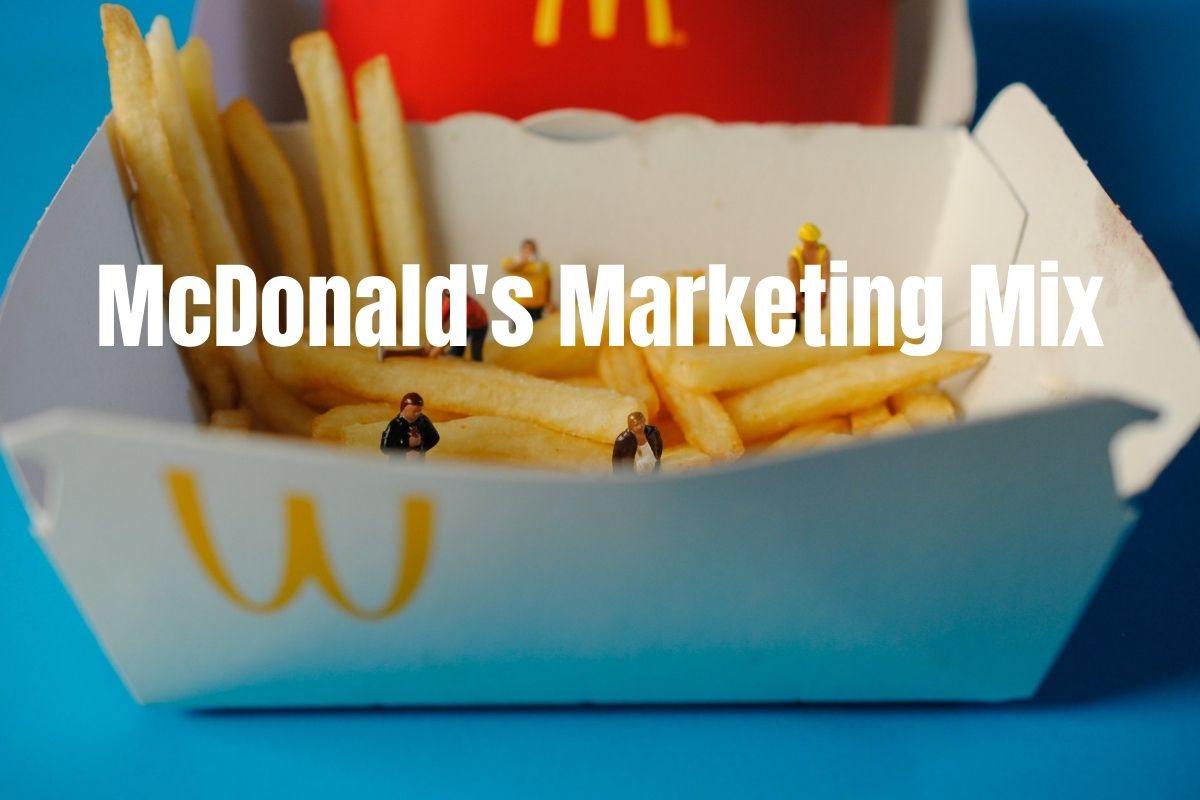
Introduction
McDonald's marketing mix strategy examines the company using the marketing mix paradigm, which includes the four Ps (Product, Price, Place, Promotion). Product development, price strategy, promotion planning, and so on are all examples of marketing tactics. These business methods, which are based on McDonald's marketing mix, aid in the success of the brand.
McDonald's marketing strategy aids the brand's/competitive company's position in the marketplace as well as the achievement of its overall business goals. To begin, let's look at McDonald's Marketing Strategy & Mix to learn about the company and its products, price, marketing, and sales channels:
Product Strategy of McDonald's
McDonald's has a product mix that is mostly made up of food and beverage items as a restaurant service company. The different organizational outputs (goods and services) that the firm delivers to its market segments are covered by this component of the marketing mix. McDonald's has the following primary product lines in their product mix:
- Coffees and Shakes
McDonald's brand and business reputation are largely determined by its products, which constitute one of the four Ps. Burgers are the company's most well-known product. The company, on the other hand, steadily extends its product variety. Customers may now order other items such as chicken and fish, desserts, and morning meals. The product lines featured in this section of the marketing mix are influenced by McDonald's generic competitive strategy and intense expansion initiatives.
The corporation meets market demand, increases revenues, and spreads risk in its business by diversifying its product lines. A broader product mix decreases the brand's reliance only on one or a few sectors of the economy in terms of risk. This component of McDonald's marketing mix denotes that the company develops new goods to gain more customers and strengthen its financial stability.
Price Strategy of McDonald's
McDonald's relies on psychological pricing methods in its marketing mix that look reasonable to customers to ensure that they buy more things. In India, they dropped rates by over 25%, so that people prefer McDonald's for mealtimes. KFC, Subway, Domino's, are its major rivals. McDonald's offers discounts or bundles on particular goods and combinations of different menu items as part of its promotional pricing strategy. Their price approach has also been tweaked to appeal to the lower middle class. McDonald's' target market consists primarily of young teens who are brand savvy and seek convenience. With the rise of home delivery, numerous reductions are now available on the overall bill amount.
Place Strategy of McDonald's
Accessibility.
McDonald's has a large number of locations in city centers and commercial malls, making it very accessible. While McDonald's is best known for its restaurants, the company also offers additional services such as dessert shops, McCafe, and even McDelivery in various areas. Some McDonald's locations are also open 24 hours a day, seven days a week, to serve customers.
Free internet is available at many McDonald's locations, making it handier and appealing to teens, business people, and even freelancers searching for a place to work. On the premises of some locales, there may even be a playground. This provides a fun space for kids to play after they've eaten, which is appealing to both kids and families.
McDonald's operates a hybrid structure of franchised and company-owned restaurants. McDonald's has more than 37,000 locations in more than 100 countries. Customers may either visit these locations to eat hamburgers or purchase items online and have them delivered to their homes. McDonald's offers customers the option of ordering food online through their website to keep up with the digital era. Customers may also order via these meal ordering applications because the firm has connected with other top food ordering providers.
Promotion Strategy of McDonald's
The strategies that the company helps to convey with customers are defined by this component of the marketing mix. This variable refers to marketing communications with target consumers among the 4Ps. To entice customers to buy new items, the corporation, for example, gives fresh information. In its promotional mix, McDonald's employs the following methods, which are listed in order of importance to the company:
- Advertisement (most significant)
- Promotions for sales
- Direct marketing
- Media relations
Among McDonald's advertising strategies, advertisements are the most well-known. Advertisements are broadcast on television, radio, newspapers, and the internet. Sales, on the other side, are utilized to attract more consumers to the company's eateries. McDonald's tailors their marketing plan to accommodate for the wide range of cultural and other differences that each country has to offer. In this context, the food business looks at consumer perceptions of its goods, consumption habits, ethnic, moral, and religious considerations, among other things.
McDonald's has several marketing campaigns in place in various countries. They recently teamed with BTS, a Korean boy band, to create a unique month-long BTS food marketing ad campaign.
McDonald's Marketing Mix (4Ps) Analysis Mind Map
Following is the mind map of the McDonald's marketing mix with the 4 P's for better understanding and visually pleasing takeaway. McDonald's has always worked along with the trends and constantly changing with the market and time. This makes McDonald's one of the best fast-food serving places all around the world.
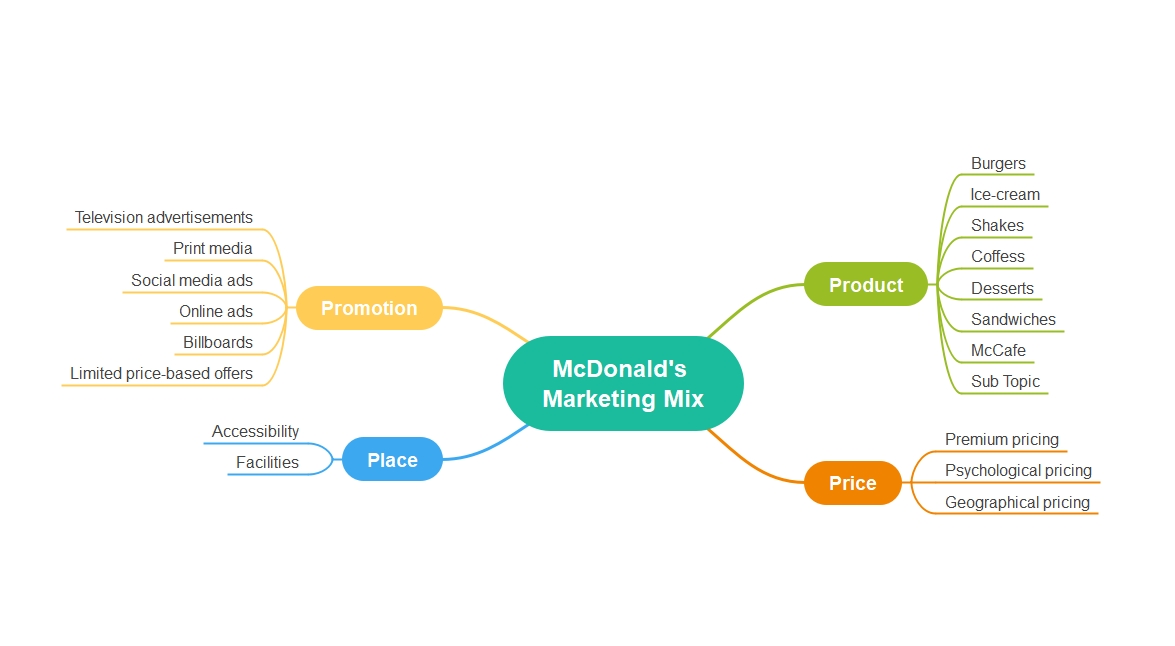
Key Takeaways
McDonald's has marketed itself as the go-to best and fastest chain for the majority of the population. Their menu is intended to attract persons of different ages, tastes, and interests. It's no wonder that McDonald's has evolved to become the world's biggest firm, thanks to its meticulously planned business strategy and marketing methods that cater to a country's interests.
EdrawMind offers the best built-in mind map templates for making the marketing mix for your job. Presentation, school work, or even your own company. A perfect and visually pleasing mind map can offer you a better understanding and learning experience. All you need to do is choose your template, edit your details, save it, and you are good to go without any fuss and time-consuming, difficult tools.
- McDonald's Marketing Mix (4Ps)
- The 4 Ps Applied to McDonald's
- Elaborative Marketing Mix of McDonalds
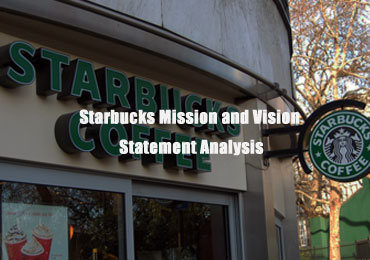
Starbucks Mission and Vision Statement Analysis

Starbucks Marketing Mix (4Ps) Analysis

Apple Segmentation, Targeting, and Positioning

Starbucks Market Segmentation, Targeting, and Positioning

The Exhaustive Guide to STP Marketing Model
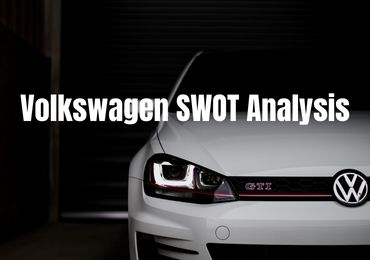
Volkswagen SWOT Analysis
- Free Samples
- Premium Essays
- Editing Services Editing Proofreading Rewriting
- Extra Tools Essay Topic Generator Thesis Generator Citation Generator GPA Calculator Study Guides Donate Paper
- Essay Writing Help
- About Us About Us Testimonials FAQ
- Studentshare
- Core Values and Marketing Strategy - McDonalds
Core Values and Marketing Strategy - McDonalds - Assignment Example
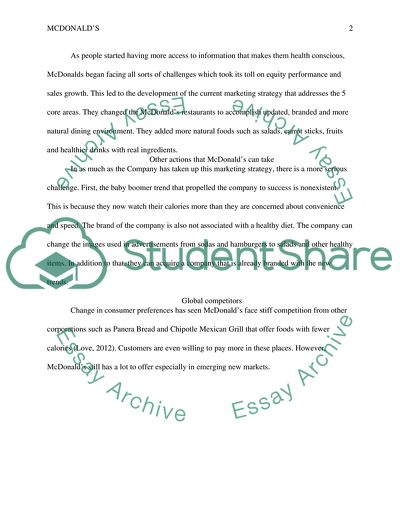
- Subject: Marketing
- Type: Assignment
- Level: College
- Pages: 1 (250 words)
- Downloads: 6
- Author: korbinmckenzie

Extract of sample "Core Values and Marketing Strategy - McDonalds"
- Cited: 1 times
- Copy Citation Citation is copied Copy Citation Citation is copied Copy Citation Citation is copied
CHECK THESE SAMPLES OF Core Values and Marketing Strategy - McDonalds
Segmented marketing and branding big mac, organizational cultural audit and gap analysis - mcdonald's, young peoples attitude to health, design of goods and services at mcdonalds, organizational cultural audit and gap analysis, mcdonalds corporation, social media critique of mcdonalds company, franchise profile project - mcdonald's.

- TERMS & CONDITIONS
- PRIVACY POLICY
- COOKIES POLICY
In-Depth McDonald’s Marketing Case Study – I’m Lovin’ It Already.
By Aditya Shastri
Quick Read McDonald’s marketing strategy revolves around innovative campaigns, digital presence, and product diversification (Expanding product offerings for variety), aiming to cater to diverse consumer needs globally. The fast-food giant’s approach focuses on customer satisfaction, quality control, and sustainability, driving its continued growth and market dominance.
Learn From Asia’s #1 Digital Marketing Institute
AI-Based Curriculum
Dive in to the future with the latest AI tools
Placement at top brands and agencies
Talk to counsellor
Forget fancy ingredients and Michelin stars. McDonald’s has conquered the fast-food world with a different kind of recipe – a patented McDonald’s marketing strategy as crave-worthy as their fries.
This case study dives into the secret sauce behind the Golden Arches’ success, exploring the innovative campaigns, strategic partnerships, and timeless principles that have kept them at the forefront of the fast-food game for decades. So, grab a virtual burger, buckle up, and get ready to uncover the marketing magic that makes McDonald’s a household name (and a billion-dollar brand).
About McDonald’s
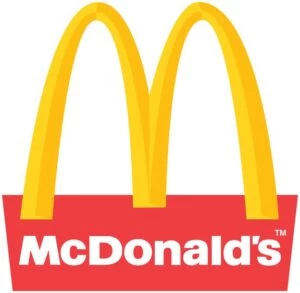
Source: Google
McDonald’s Corporation, or simply McDonald’s, is the world’s largest chain of fast-food restaurants, serving around 69 million customers per day.
The company, originally established in 1940 as a restaurant by Richard and Maurice McDonald, initially operated as a hamburger stand when it was reorganised in 1948. Businessman Ray Kroc joined the company in 1955 as a franchise agent, eventually acquiring the chain from the McDonald brothers and overseeing McDonald’s growth strategy and subsequent expansion..
The mission of the company is, “To create delicious feel-good moments for everyone” .
McDonald’s offers its customers a wide variety of menu items, along with drinks and other merchandise. It is known for its employee satisfaction, innovation, and commitment to quality.
McDonald’s Marketing Strategy – What’s New With the Brand?
Here’s everything that was buzzing around McDonalds recently:
- McDonald’s in India ceased including tomatoes in August 2023 due to escalating prices, and they have introduced the new “KARTIK AARYAN Meal,” inspired by the actor’s persona, which we will delve into further in the marketing strategies section below.
- McDonalds in India dropped tomatoes in August of 2023 because of rising prices.
- McDonald’s giving away free NFTs in Singapore.
- In July 2023, McDonald’s announced that they are coming up with a new concept called CosMc – a spinoff restaurant.
- McDonald’s opened their first fully automated restaurant in Texas.
- In 2023, McDonald’s reported a revenue of $23.2 billion (Source: McDonald’s Annual Report 2023).
- McDonald’s operates over 38,000 outlets worldwide (Source: Statista, 2023).
- McDonald’s commands a significant 21.4% stake in the worldwide fast-food market, according to IBISWorld’s 2023 report.
Business News
McDonald’s has announced plans to invest $1 billion in renovating its stores across Europe, focusing on enhancing customer experience through digital kiosks and modernised interiors (Source: BBC News, June 2024).
Product Launch
The brand has introduced the McPlant, a plant-based burger, in collaboration with Beyond Meat, aiming to capture the growing vegan and vegetarian market (Source: The Guardian, May 2024).
Marketing News
One recent McDonald’s marketing strategy titled ‘Famous Orders,’ featured celebrities’ favourite McDonald’s meals, which has garnered significant social media engagement (Source: Marketing Week, April 2024).
Celebrity News
Rapper Travis Scott partnered with McDonald’s to launch a special meal, leading to a 4% increase in sales in the US during the promotion period (Source: Forbes, March 2024).
Sounds like the marketing strategy of McDonald’s was quite the talk of the town all this year and rightfully so. Let’s now move on and discuss the buyer persona of McDonalds.
Check out IIDE’s Digital Marketing Course Online and learn the right way to build digital marketing strategies for big brands.
Marketing on McDonald’s – Marketing Mix
A marketing mix is a model that an organisation uses to better advance its interest in its image or product. The main components of this model are the 4Ps: Product, Price, Place and Promotion. So let us look at McDonald’s marketing mix strategy in the coming section
We have written a separate blog taking a deeper dive into the marketing mix of McDonald’s if you wish to learn more.
Product Strategy of McDonald’s
As a fast-food company, its main offerings include burgers, French fries, breakfast items, soft drinks, milkshakes, and desserts.
McDonald’s menus are known around the globe, although there are geographic variations to suit the local preferences & tastes of customers. The company continuously improves its products and services based on the changing needs and tastes of consumers.
The core value of what McDonald’s offers has always been fast service which is a huge value addition. Nowhere else can you get such a range of items at even lower prices with such efficiency, convenience and customer service.
Price Strategy of McDonald’s
The pricing strategy of McDonald’s has always been to offer food at low prices. This is what has allowed the restaurant to be successful for many years.
This also has primarily helped McDonald’s build its reputation as one of the top fast-food brands in the world. However, with the costs of living continuing to rise, McDonald’s has begun offering combos and specials to entice customers and churn out profits through economies of scale.
In India, the brand introduced a catchy slogan – “Aap Ke Zamane Mein, Baap Ke Zamane Ke Daam”. This was done back in 2008 to attract lower and middle-class customers to experience the offerings of McDonald’s India and it worked out very well.

Place and Distribution Strategy of McDonald’s
McDonald’s is one of the world’s leading quick-service restaurants (QSR) with over 38,000 restaurants in 100+ countries. It recently opened nearly 1,000 new restaurants globally & also modernised another 900 restaurants in the US.
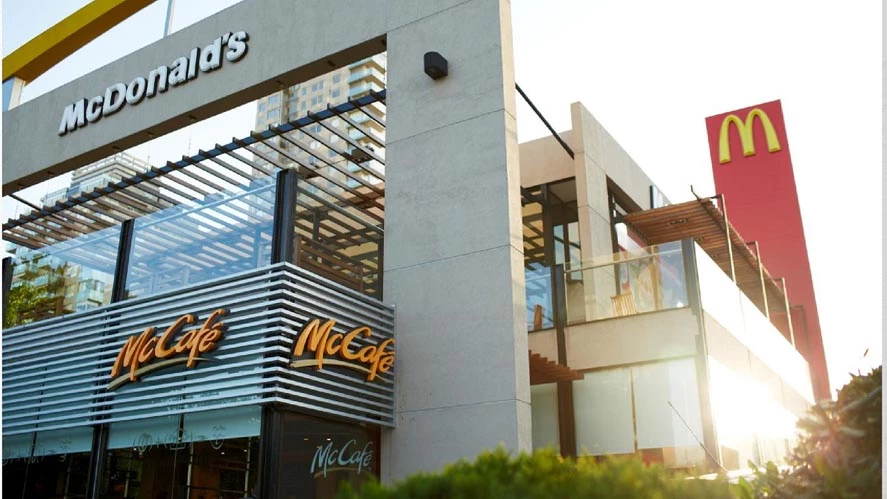
It has opened different restaurant formats, drive-ins, online ordering, and tying with food delivery partners . These new formats allow the customers to get the desired food at a particular time and place which also helps them to have a better experience overall. The stores themselves are clean unlike others as they always keep their outdoor seating space sanitised while having indoor seating areas for an elegant ambience.
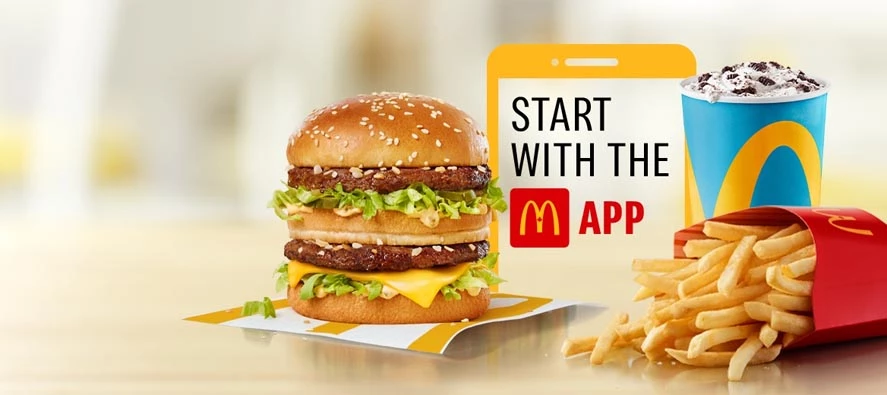
Promotion – McDonald’s Advertising Strategy
McDonald’s uses a lot of promotional techniques as promotional activities help build brand loyalty and interest. It gives people who may not normally go to McDonald’s a reason to go there.
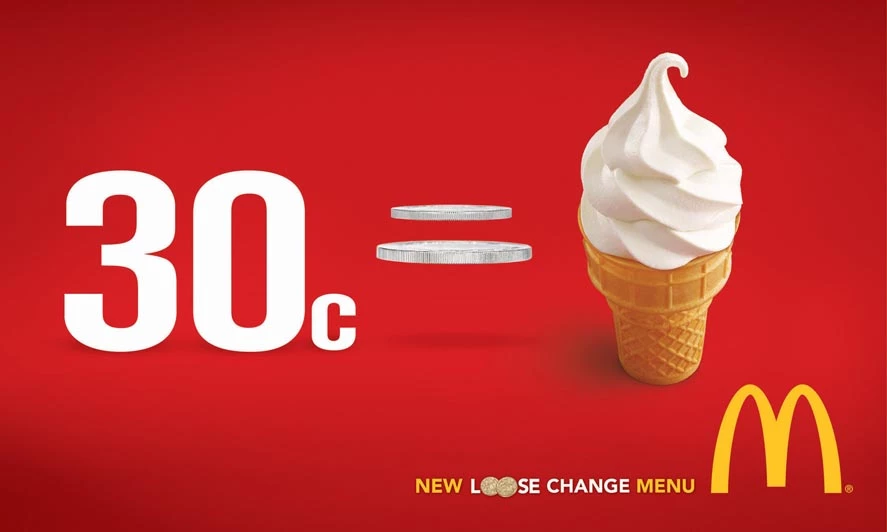
Just like any other company, McDonald’s also sponsors various promotion campaigns to push their brand. Promotions help in creating a sense of community and association between the company and its customers.
🚨 FREE MASTERCLASS
Building a Profitable Instagram Strategy
Worked with:
Register For Free
IG Content Creater With 10+ million views
McDonald’s Marketing Case Study – Buyer Persona
A buyer persona generally refers to the detailed information of the ideal customer of a company. When it comes to McDonald’s, people from all countries, ages, and genders enjoy their juicy burgers and fries. Hence, we have focused on the attributes of an ideal buyer at McDonald’s.

Buyer’s Persona
Profession:
Graphic Designer
- Seeks quick, convenient meals
- Values cost-effectiveness
- Enjoys variety and occasional indulgences
- Prefers shareable food options
Interest & Hobbies
- Digital Art & Design
- Socialising with friends
- Watching movies and TV series
- Exploring new cafes and restaurants
Pain Points
- Time-strapped due to work
- Dislikes long wait times
- Concerned about food consistency
- Health-conscious
- Prefers a quieter ambience
Social Media Presence
McDonald’s leverages buyer personas to tailor marketing strategies that resonate with digitally savvy, socially active individuals who value convenience and variety. This approach helps McDonald’s targeted campaigns that engage customers across different platforms while addressing their specific preferences and lifestyle needs.
Wish to work with reputed brands? You should take a look at IIDE’s Digital Marketing Courses with Placements and learn how their courses can help you to bag a job in reputed companies.
McDonald’s Marketing Strategy: An Overview
McDonald’s employs a multi-faceted marketing strategy that includes traditional advertising, digital marketing, and community engagement. Recently, McDonald’s advertising strategy has focused on digital transformation, integrating mobile app promotions, loyalty programs, and online ordering to enhance customer convenience. The ‘Famous Orders’ campaign is a prime example, effectively leveraging celebrity endorsements to drive sales and brand visibility.
With an innovative approach to marketing and consumption patterns through value-added menu improvements, McDonald’s aims to significantly improve market share in key markets through continually improving customer satisfaction and attracting new customers through cost savings, operational efficiencies and improving brand awareness.
So let us look at some of McDonald’s marketing strategies over the past years.
A Detailed Look at McDonald’s Franchise Model
McDonald’s didn’t just revolutionise fast food; they revolutionised franchising. Their model has become the industry gold standard, with countless companies trying to capture a piece of the Golden Arches magic.
But what’s the secret sauce behind their success? Two key ingredients: consistency and customisation. McDonald’s made a massive investment in ensuring all franchises deliver the same high-quality experience, no matter where you are in the world. This meant sourcing ingredients locally and crafting menus that cater to regional tastes.
By prioritising consistency and local flair, McDonald’s unlocked the formula for global domination. They weren’t just selling burgers; they were selling a familiar, reliable experience that transcended borders.
Of course, McDonald’s isn’t the only one with a franchise model that’ll knock your socks off. Check out our list of digital marketing case studies to know more.
Catering to an Audience of All Ages
The company understand that families come in all shapes and sizes, with appetites to match. That’s why McDonald’s has become a master of menu magic, catering to every age group.
Think bright, colourful Happy Meals that turn mealtime into an adventure for the little ones. Parents can grab a satisfying burger and fries, while larger appetites can conquer supersized portions. It’s a win-win for everyone, ensuring no one leaves hungry or disappointed. McDonald’s product strategy is simple: Offer delicious food in convenient packages that fit every family’s needs. It’s a recipe for success that’s kept them at the forefront of the fast-food game for generations
McDonald’s – I’m Lovin’ It… Para Pap Pap Paa:
“I’m Lovin’ It… Para Pap Pap Paa” is a very well-known jingle that has been one of the best McDonald’s marketing tactics for a very long time now.
This jingle highlights the positive experience one can have while dining at McDonald’s. The jingle is memorable because it speaks about how happy consumers are during their meals there, and how helpful and friendly the employees are.
Brand Mascot of McDonald’s
McDonald’s struck gold in 1963 with a character who’d become a pop culture icon: Ronald McDonald. This wasn’t just some painted-on smile. Ronald’s infectious cheer and bright red threads resonated with both kids and adults. He wasn’t just a clown; he was the embodiment of McDonald’s fun, family-friendly vibe. Fast forward to today, and Ronald remains a cornerstone of McDonald’s marketing strategy. He’s a walking, talking symbol of happy meals, birthday parties, and that unmistakable sense of childhood wonder. So next time you see those golden arches, remember the red-haired maestro behind the success: Ronald McDonald, the undisputed king of McDonald’s mascots.
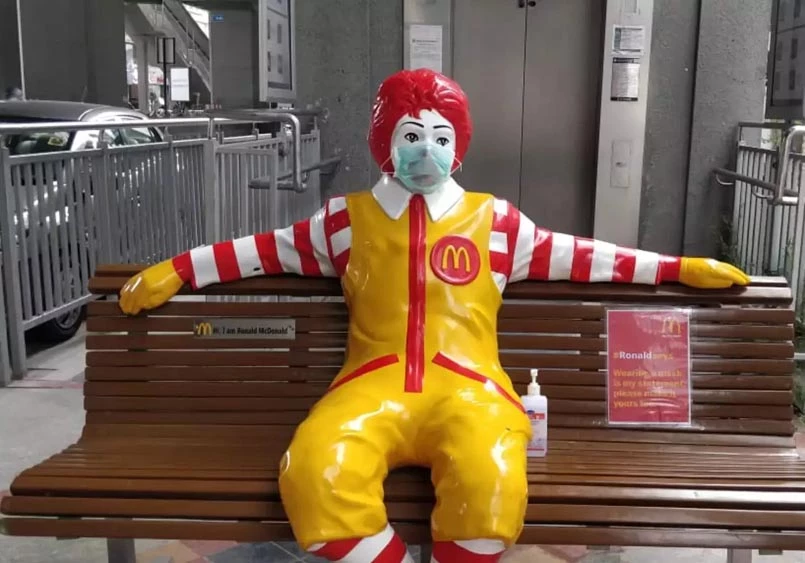
Believe it or not, coming up with the perfect mascot for your brand is pretty easy, provided you know what to consider when doing it. Lucky for you, if you’re based in Gurgaon, there are several options for you to choose from. Check out our blog on the best digital marketing courses in Gurgaon to know more.
Collaborations with McDonald’s
McDonald’s has a long history of collaboration with various companies and artists. The motive behind these collaborations is to maintain its brand reinforcement in the minds of its customers. This goes beyond simply creating advertising campaigns that promote the value of its products.
The company very recently collaborated with BTS – the very popular South Korean Music band where it introduced a special McDonald’s meal called the BTS Meal. Likewise, it has collaborated with artists like Travis Scott, and J Balvin as well as Companies like Coca-Cola. These collaborations are an integral part of McDonald’s growth strategy.
Interestingly, McDonald’s strategy can be a part of the curriculum of several digital marketing classes. Here, students are taught to analyse the impact of such collaborations. Check out our article on the best digital marketing courses in mumbai to know more.
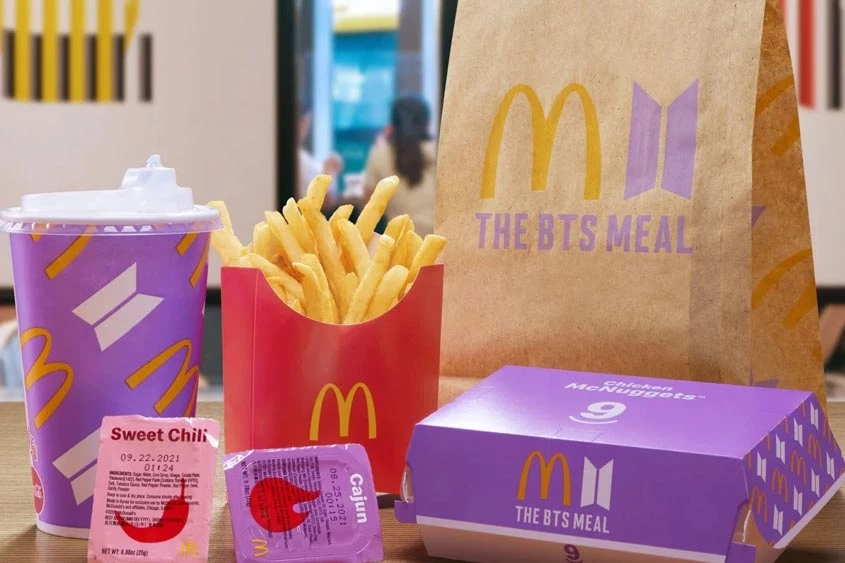
You can also create amazing strategies for your own business or for big brands like McDonald’s, and hence you should enrol for our free top-paying skills course and learn the skills that are demanded in this industry.
Digital Marketing Strategies of McDonald’s
SEO Strategy: Of course, this wouldn’t be McDonald’s SEO case study, without highlighting its optimisation practices in brief. The company optimises its website with relevant keywords such as ‘McDonald’s near me’ and ‘McDonald’s menu’ to attract local traffic (Optimizing for local search results) and improve search engine rankings (Positioning on search engine results page). The company also found that its ‘organic’ practices perform better than “sponsored” promotions. This is a testament to the efficiency of McDonald’s marketing strategy.
SMM Strategy: McDonald’s serves up engaging content, and interactive polls, and even integrates customer feedback on platforms like Twitter and Instagram. Remember the Travis Scott meal campaign? That sizzling collaboration wasn’t just a tasty treat, it was a social media goldmine, boosting online engagement to a whole new level. This focus on interactive and customer-centric content is a key ingredient in McDonald’s marketing strategy, proving that social media is more than just a platform – it’s a powerful tool for building brand loyalty and driving sales. Are you interested in exploring the wonders of social media? You should try out our free Instagram marketing course and learn what this industry is all about.
By encouraging its customers to click pictures of their meals and post them on various social media platforms. This growing food photography trend has helped McDonald’s to lure new customers, in fact, between the period of September 2018 and February 2019, there were 4.9 million McDonald’s logos posted on Twitter globally.
But wait, there’s more! (See what we did there?) If you’re hungry for even more digital marketing insights, check out our free LinkedIn masterclass and unlock the power of this professional platform for your business growth !
E-commerce Strategy: McDonald’s has enhanced its e-commerce presence through partnerships with food delivery services like Uber Eats and DoorDash, facilitating online orders and delivery. The app is a vital part of how McDonald’s markets itself in the digital age.
Mobile App: The McDonald’s mobile app offers exclusive deals, order tracking, and a rewards program, improving customer loyalty and satisfaction.
Influence Marketing Strategy: Collaborations with influencers and celebrities have been a cornerstone of McDonald’s marketing, with the ‘Famous Orders’ campaign exemplifying this approach
By adopting digital marketing practices, McDonald’s has been able to increase its brand awareness and create demand for its offerings. The information promoted is similar to the ones used in traditional marketing platforms such as TV, billboards, newspapers, etc., however, the execution of the same content differs.
Want to learn how to market your products like a pro? Check out our article on the best digital marketing courses in Kolkata.
Marketing & Advertising Campaigns of McDonald’s India
A marketing campaign can have many goals, but at its core, it’s all about getting more customers. An effective and well-timed campaign will create a demand which then supports the product or service.
McDonald’s always has a very strong strategy in place. Right from showcasing its delicious burgers along with bringing out the positive McDonald’s vibe to ending the commercials with slogans like, ‘I’m Lovin’ It… Para Pap Pap Paa’ , very few businesses can keep up with the fast food giant’s marketing campaign game
So let us look at some of the popular campaigns of McDonald’s.
1) Kartik Aaryan Meal by Mcdonald’s India
Mcdonald’s India introduced the new Kartik Aaryan Meal including burgers, fries, and a pizza puff with a different packaging than unusual. The meal also features a QR Code, which upon scanning, fans can take a selfie with him virtually.
2) We Get It – Campaign & Commercial Ad
Another campaign launched by McDonald’s India was titled ‘We Get It”’ and revolved around the craziness of life and how McD continues to make you feel special and give the best experience through that.
3) There’s A McCafe for Every Moment
McDonald’s India introduced the ‘There’s A McCafe for Every Moment’ campaign to spotlight its beverage offerings under McCafe, emphasising their presence in life’s diverse moments, whether positive, challenging, or ordinary. Launched in 2017, the campaign creatively captured everyday nuances through a memorable theme song.
4) Family Time Means McDonald’s #Mealsmakefamilies
McDonald’s India came up with this campaign to highlight how meals bring families together. This campaign which was launched recently showcases some relatable moments people share with families while having a McDonald’s meal.
5) Marketing & Advertising Campaigns of McDonald’s during the Covid-19 Pandemic:
McDonald’s released a series of advertising commercials showcasing how so many things have changed since the pandemic. The basic idea behind the campaign was to highlight how life has changed but McDonald’s is still there, offering the same positive experience with extra hygiene and safety measures.
6) #MatchedByYou – A Marketing Campaign of McDonald’s India
McDonald’s introduced an exciting campaign #MatchedByYou. This campaign highlighted the availability of food combos starting at just ₹45, portraying a love triangle among burgers, fries, and cola.
After reading the McDonald’s marketing strategy, I suggest that you take a deeper look into the SWOT Analysis of McDonald’s.
Top Competitors That Influence McDonald’s Marketing Strategy
Like fast fashion, fast food outlets are also trying to get a share of the monopoly that McDonald’s once enjoyed. Here are a few top competitors of McDonald’s in India as well as internationally:
- Burger King: Known for its flame-grilled burgers and innovative marketing strategies.
- KFC: Specialises in fried chicken and has a strong global presence.
- Subway: Offers a healthier fast-food alternative with its customisable sandwiches.
- Wendy’s: Competes with McDonald’s on quality and customer service.
- Starbucks: Although primarily a coffee chain, it competes in the breakfast and snack segments.
Those interested in learning about McDonald’s and its competitor’s strategy can benefit from enrolling in a PG in digital marketing to understand similar corporate strategies in-depth.
McDonald’s Marketing Strategies – Failed Campaigns
We looked at the campaigns that brought the essence of McDonald’s to everyone’s screen but now let’s look at some of the failed campaigns that didn’t hit a chord with the audience.
1. #McDStories on Twitter
In the late 2010s, McDonald’s introduced a hashtag on Twitter – #McDStories & that encouraged their fans to share their stories revolving around the Happy Meal.
What the brand expected was stories that would inspire people to get together with their friends and family to enjoy a Happy Meal.
Instead, Twitter users started using this hashtag sarcastically and shared their negative experiences with McDonald’s.
Here’s one of the tweets using #McDStories:
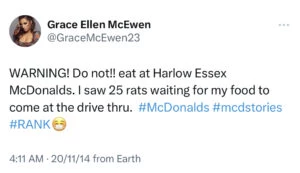
Source: Goggle
2) Controversial Ad in India
In 2023, McDonald’s released a commercial ad where a customer was wooing a female staff member. The ad didn’t go well without the viewers and faced a lot of backlash.
McDonald’s is one of the world’s most recognised fast-food restaurants. With annual revenues over $19 billion, there’s no doubt that McDonald’s has a major influence on society in terms of food choices.
Its influence spans numerous nations globally. With a strong presence on both offline and online marketing, and cruise control over production and distribution, McDonald’s looks very well placed to take up industry-changing challenges. This comprehensive overview highlights McDonald’s growth strategy and its impressive ability to adapt to changing market conditions.
Let us know your thoughts on this McDonald’s marketing case study in the comment section below. Thank you for reading, and if you liked our then do share this in your circle.
Learning from Other Brands
In comparison, the marketing strategy of Puma focuses heavily on collaborations with athletes and sports personalities, similar to Spotify’s approach to collaborating with artists.
Additionally, the marketing strategy of Nykaa highlights the importance of influencer partnerships and personalised customer experiences, providing a broad perspective on how beauty brands can excel.
Similarly, the marketing strategy of Spotify leverages data-driven insights and personalized recommendations, showcasing how technology and user data can drive brand loyalty and market leadership.
FAQs About Marketing Strategy of McDonald's
McDonald's marketing strategy focuses on digital transformation, innovative campaigns, and customer-centric approaches to drive growth.
McDonald's markets itself through a mix of traditional advertising, digital marketing, influencer collaborations, and community engagement.
McDonald's growth strategy includes global expansion, menu innovation, and enhancing digital capabilities to meet evolving customer needs.
Famous campaigns include the "Famous Orders" campaign featuring celebrities and the "I'm Lovin' It" global campaign.
McDonald's main competitors are Burger King, KFC, Subway, Wendy's, and Starbucks.
McDonald's employs SEO, social media marketing, e-commerce, mobile app integration, and influencer marketing strategies.
Yes, the #McDStories Twitter campaign in 2012 faced backlash and had to be withdrawn due to negative customer stories.
McDonald's target audience is motivated by convenience, affordability, and familiarity with the brand.
Pain points include health concerns related to fast food, environmental impact, and the need for diverse menu options.
McDonald's is active on platforms like Instagram, Twitter, and TikTok, engaging with users through interactive posts and influencer collaborations.
Author's Note: My name is Aditya Shastri and I have written this case study with the help of my students from IIDE's online digital marketing courses in India . Practical assignments, case studies & simulations helped the students from this course present this analysis. Building on this practical approach, we are now introducing a new dimension for our online digital marketing course learners - the Campus Immersion Experience. If you found this case study helpful, please feel free to leave a comment below.
IIDE Course Recommendation

" * " indicates required fields
Get Syllabus
By providing your contact details, you agree to our Terms of Use & Privacy Policy
Aditya Shastri
Lead Trainer & Head of Learning & Development at IIDE
Leads the Learning & Development segment at IIDE. He is a Content Marketing Expert and has trained 6000+ students and working professionals on various topics of Digital Marketing. He has been a guest speaker at prominent colleges in India including IIMs...... [Read full bio]
This is a concise and well written case study of Mc Donald’s. It will be useful for Management students .
One of the best detailed report i have read. Great work, great research.
Very well written blog on mcdonalds marketing strategy which makes us understand how McDonald’s is growing instead of so much competition
McDonald’s leverages nostalgia and innovation, captivating diverse consumer demographics effectively.
Submit a Comment Cancel reply
Your email address will not be published. Required fields are marked *
Submit Comment
This site uses Akismet to reduce spam. Learn how your comment data is processed .
Related Posts

Case Study on the Valuable Business Model Of VISA with Full Explantation
by Aditya Shastri | Aug 20, 2024
Quick Read Explore the business model of Visa Inc., a global leader in payment technology....
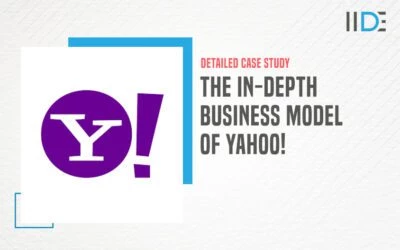
Here’s an In depth Analysis On the Business Model Of Yahoo
by Aditya Shastri | Aug 17, 2024
Looking for the business model of yahoo? Here's an in-depth analysis of it. Yahoo is one of the...
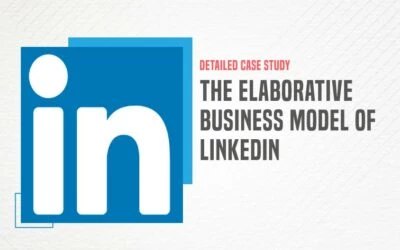
Elaborative Business Model Of LinkedIn – Detail Explanation
by Aditya Shastri | Aug 16, 2024
Quick Read The business model of LinkedIn leverages a robust freemium structure, offering...
I’m Interested in This Masterclass
Academia.edu no longer supports Internet Explorer.
To browse Academia.edu and the wider internet faster and more securely, please take a few seconds to upgrade your browser .
Enter the email address you signed up with and we'll email you a reset link.
- We're Hiring!
- Help Center

Assignment on Mcdonald's

Related Papers
MUHAMMAD IMAD UD DIN
Loading Preview
Sorry, preview is currently unavailable. You can download the paper by clicking the button above.
RELATED TOPICS
- We're Hiring!
- Help Center
- Find new research papers in:
- Health Sciences
- Earth Sciences
- Cognitive Science
- Mathematics
- Computer Science
- Academia ©2024
YOUR FINAL GRADE - GUARANTEED UK Essay Experts
Disclaimer: This essay is provided as an example of work produced by students studying towards a commerce degree, it is not illustrative of the work produced by our in-house experts. Click here for sample essays written by our professional writers.
Any opinions, findings, conclusions or recommendations expressed in this material are those of the authors and do not necessarily reflect the views of UKEssays.com.
The Assignment Of The Mcdonalds Business Commerce Essay
| ✅ Free Essay | ✅ Commerce |
| ✅ 3804 words | ✅ 1st Jan 2015 |
Reference this
Cite This Work
To export a reference to this article please select a referencing stye below:
Related Services

Essay Writing Service

- Dissertation Writing Service

- Assignment Writing Service
DMCA / Removal Request
If you are the original writer of this essay and no longer wish to have your work published on UKEssays.com then please:
Our academic writing and marking services can help you!
- Find out more about our Essay Writing Service
- Undergraduate 2:2
- 7 day delivery
- Marking Service
- Samples of our Service
- Full Service Portfolio
Related Lectures
Study for free with our range of university lecture notes!
- All Available Lectures

Freelance Writing Jobs
Looking for a flexible role? Do you have a 2:1 degree or higher?
Study Resources
Free resources to assist you with your university studies!
- Dissertation Resources at UKDiss.com
- How to Write an Essay
- Essay Buyers Guide
- Referencing Tools
- Essay Writing Guides
- Masters Writing Guides
- SUGGESTED TOPICS
- The Magazine
- Newsletters
- Managing Yourself
- Managing Teams
- Work-life Balance
- The Big Idea
- Data & Visuals
- Reading Lists
- Case Selections
- HBR Learning
- Topic Feeds
- Account Settings
- Email Preferences
McDonald’s and the Challenges of a Modern Supply Chain
Three lessons.
Recently, McDonald’s, the world’s iconic largest food service provider, has been (forgive the cliché) through the grinder. Poor performance has led to the departure of its CEO and plenty of critical attention in the business pages . Part of this story relates to the provenance, or origins, of its products: Chains that provide more upmarket “fast casual” dining such as Panera, Chipotle, and Shake Shack have brands that speak of freshness, health, and trustworthy sourcing.
- Steve New teaches operations and supply-chain management at the University of Oxford’s Saïd Business School and is a fellow of Hertford College.
Partner Center
McDonald’s Case Study Problem Statement: Improper Resource Management
- To find inspiration for your paper and overcome writer’s block
- As a source of information (ensure proper referencing)
- As a template for you assignment
McDonald’s Statement of the Problem or Opportunity
Mcdonald’s problem statement: alternatives, mcdonald’s problem: analysis of the alternatives, recommendation, works cited.
There is lack of proper management of resources within McDonald restaurants and this has led to tremendous drop in sales over the years. Most of the stores in the Far East have closed due to economic downturn. At the same time consumers are shifting their tastes and preferences from hamburgers to other types of food. This has contributed to low sales since the number of people visiting the stores decreased over the years.
The number of prospective franchisees has also decreased attributing their exit to poor customer turnout owing to cheap brand that McDonald has exposed itself to by offering too much discounts on its products. The firm is also experiencing poor quality services and uncleanliness; this is due to laxity by the top management making them not to inspect the franchises. There is also lack of skilled manpower due to postponement of training sessions that were once used to equip employees.
The company need to work out on their business models through appropriate segmentation to enable them work comfortably with the changing market economy. Professional training of the employees on the marketing and sales strategies needs to be resumed. The firm at the same time need to diversify its sales in order to catch up with the consumers changing trends on tastes.
These other food products must be accompanied by quality services including reasonable prices. McDonalds should also improve on the quality of their burgers by inventing new and unique recipe. This can only be achieved by utilizing the most creative franchisees having high skilled employees (McDonald et al 335-352).
There is need to recruit managers who are capable of implementing the firms marketing programs and at the same time have the ability of building internal cohesion (Johlke and Duhan 265-267). The manager must have the ability to motivate and unite employees from the franchises to the head office.
The managers must possess the ability to control and cope with major changes and challenges within the market. The managers need to acquire valuable information on the current market trends without relying so much on their past performances. They need to improve on their level of interaction and communication with their franchisee.
Making training mandatory for every employee on a regular basis might see an improvement in the level of skilled manpower. This can be used to enhance marketing effectiveness as well as the level of performance. Recruiting experienced managers will ensure that proper tactics are implemented to regain the control of the market.
This will also ensure that the human resource have the right people for right duties (Cravens and Piercy 2009). McDonalds have kept on changing its managers due to poor performances and inability to implement quality strategies for quality services. Like in this case, poor management led to McDonalds closing over seven hundred restaurants (Gogoi and Michael 281-284).
Looking for the alternative food stuff for consumers might not look effective at the start since there are many consumers who are now used to the supplies from other potential competitors. Improving the recipe will not also realize much change because according to research ratings, the consumers prefer being served with firms that offer better quality services.
According to the research carried out, companies like Wendy and Chick-fill-A Inc were ranked a head of McDonald. McDonald’s competitors offer far better quality food stuff than them and this might mean that McDonald will really have to improve on their sales and marketing tactics in order to convince consumers (Kohli 53-8).
There is need to analyze other competitors intentions and strategies in order to find the best counteractive approach. The need for good management team will enhance the provision of good brand and articulation of all the elements that comprise marketing mix. The products, pricing and the way of marketing must change for growth and improvement to be realised.
Cravens, David and Piercy, Nigel. “Strategic Marketing”. McGraw Hill. 9 th edition. 2009.
Gogoi, Pallovi and Michael, Arndt. “McDonald’s Corporation”. Business week , New York, (2003): 281-284.
Johlke, Mark and Dale Duhan. “Testing Competing Models of Sales Force Communication”. Journal of Personal Selling & Sales Management . USA Vol. 21 (4), (2000): 265-277.
Kohli, Jaworski. “Market orientation: Antecedents and consequences”. Journal of Marketing; New York 57, (3) (1993): 53-81.
McDonald, Malcolm et al. “Corporate Marketing and Service Brands—Moving Beyond the Fast-Moving Consumer Goods Model.” European Journal of Marketing ; London. Vol. 35 (3/4), (2001):335-352.
- Strategies and Policies at the Apple, Inc.
- Dell Inc.'s Human Resource Management Problems
- Chick Corea's "Spain" Jazz Song
- Forever Yogurt Shops' Franchisees
- Turkey Cooking: Festive Recipe
- Evaluation of the MMM Website
- Advantages and Disadvantages of Types in Organization Business Forms
- Outsourcing: Reducing Cost Without Sacrificing Growth
- Satellite Digital Audio Radio Service’s Efficient Communication
- Companies That Use Expectancy Theory: SAS Motivation
- Chicago (A-D)
- Chicago (N-B)
IvyPanda. (2018, July 8). McDonald's Case Study Problem Statement: Improper Resource Management. https://ivypanda.com/essays/mcdonalds-case-study/
"McDonald's Case Study Problem Statement: Improper Resource Management." IvyPanda , 8 July 2018, ivypanda.com/essays/mcdonalds-case-study/.
IvyPanda . (2018) 'McDonald's Case Study Problem Statement: Improper Resource Management'. 8 July.
IvyPanda . 2018. "McDonald's Case Study Problem Statement: Improper Resource Management." July 8, 2018. https://ivypanda.com/essays/mcdonalds-case-study/.
1. IvyPanda . "McDonald's Case Study Problem Statement: Improper Resource Management." July 8, 2018. https://ivypanda.com/essays/mcdonalds-case-study/.
Bibliography
IvyPanda . "McDonald's Case Study Problem Statement: Improper Resource Management." July 8, 2018. https://ivypanda.com/essays/mcdonalds-case-study/.

Implementation of Drive-Thru Windows at McDonald's Stores
Added on 2019-09-19

End of preview
Want to access all the pages? Upload your documents or become a member.
Data Analysis Case Study lg ...
Mcdonald's franchising strategies and opportunities lg ..., management by objectives - mcdonald's case study lg ..., marketing and business activities lg ..., group business plan for dtes: strategies for designing and sustainability lg ..., approaches of capacity management in mcdonald's lg ....

IMAGES
COMMENTS
McDonald's executives have noticed the potential and importance of every P, and the company plans to apply all the Ps in its marketing plan. McDonald's is using this strategy in order to focus on its right priorities, such as keeping its brand relevant and meeting the needs of ever-changing customers, more so with regard to healthy food.
McDonald's truly is a one-of-a-kind company in the modern fast food industry. Remaining at the top of the world's most famous fast food services list, it maintains an extraordinarily strong presence in the global market and remains memorable and easily distinguishable from the rest of similar organizations. The success of the organization ...
Executive Summary. McDonald's Corporation is a "Centralized, International company", which competes in the fast food industry supplying hamburgers, french fries and other consumable items using standardization, heavy expansion and branding as the driving force. McDonald's operates in over 121 countries and has over 30,000 restaurants ...
McDonald's is the largest and most popular of the fast-food chain restaurants in the world. It was founded by Dick and Mac McDonald in California in the year 1940 and facilitated by the initiation of franchised restaurants by Ray Kroc. MacDonald's serves approximately 47 million clients per day. They have approximately 30,000 outlets ...
With the 10 decisions of operations management, McDonald's optimizes the business to counteract competition. The company competes with Wendy's, KFC, Dunkin', Burger King, Subway, and Arby's.McCafé operations also compete with Starbucks and Tim Hortons, as well as some PepsiCo beverages and Unilever's Bru coffee, which can be purchased online in various countries.
1954: Ray Kroc joins the company. 1961: Kroc buys out the McDonald brothers. 1962/63: McDonald's launches the golden arches and Ronald McDonald. 1963: Ronald McDonald takes center stage in McDonald's first TV commercial. 1967: Kroc takes over as CEO. 1967: McDonald's opens its first international restaurant in Canada.
Conclusion. McDonald's marketing strategy across the various offline and online methods has allowed the company to maintain its leadership position in the fast-food business. The target audience is families that allow most of the population to feel comfortable at the restaurant. McDonald's marketing strategy across the digital channels helps ...
McDonald's marketing mix strategy examines the company using the marketing mix paradigm, which includes the four Ps (Product, Price, Place, Promotion). Product development, price strategy, promotion planning, and so on are all examples of marketing tactics. These business methods, which are based on McDonald's marketing mix, aid in the success ...
The paper "Core Values and Marketing Strategy - McDonalds " discusses that McDonald's is a corporation that has been in existence since the 1940s and has the. StudentShare. Our website is a unique platform where students can share their papers in a matter of giving an example of the work to be done. ... McDonalds - Assignment Example. Add to ...
SCM assignment - McDonalds Free Essay Example. SCM assignment - McDonalds. Categories: Business Food Information Mcdonald'S Supply Chain Management. Download paper. Download. Assignment, Pages 9 (2235 words) Views. 295. Save to my list.
McDonald's Marketing Assignment - Free download as PDF File (.pdf), Text File (.txt) or read online for free. McDonald's is an American hamburger and fast food restaurant chain. It was founded in 1940 as a barbecue restaurant operated by Richard and Maurice McDonald
Rapper Travis Scott partnered with McDonald's to launch a special meal, leading to a 4% increase in sales in the US during the promotion period (Source: Forbes, March 2024). Sounds like the marketing strategy of McDonald's was quite the talk of the town all this year and rightfully so.
McDonald's first filed for a U.S. trademark on the name "McDonald's" on May 4, 1961, with the description "Drive-In Restaurant Services", which continues to be renewed through the end of December 2009. In the same year, on September 13, 1961, the company filed a logo trademark on an overlapping, double arched "M" symbol.
This assignment based upon a company McDonalds. In today's economic competitive environment business go through structural and occupational changes, some are for the better and other for the worse. In with contract of managing change of McDonald's i am going to discuss history and background of the organisation ,the changes that are being ...
Recently, McDonald's, the world's iconic largest food service provider, has been (forgive the cliché) through the grinder. Poor performance has led to the departure of its CEO and plenty of ...
food and service Visit after Visit, Store after Store. Every hamburger, for example, was dressed in exactly the same way: mustard first, then ketchup, onions, and two pickles. One competitor marveled at McDonald's record Of consistency: 'I've been to McDonald's in Tokyo, Vienna, and Australia, and I a great sense Of having the
McDonald's Statement of the Problem or Opportunity. There is lack of proper management of resources within McDonald restaurants and this has led to tremendous drop in sales over the years. Most of the stores in the Far East have closed due to economic downturn. At the same time consumers are shifting their tastes and preferences from ...
As of 2020, 54% of women are staff at McDonald's. 41% of these women are directors at McDonald's and 30% are officers at McDonald's. One of McDonald's goals are to increase the percentage of women working in management roles by 45% by the end of 2025. Looking at this it is clear that McDonald's empowers women under clearly diverse in gender.
Implementation of Drive-Thru Windows at McDonald's Stores. ASSIGNMENT 2 1 Executive Summary The report is being prepared to solve the issue of McDonald's in New Zealand. The company is not able to provide great quality services to the customers because the employees are busy all the time in attending the customers and most of the customers ...
'backward' Russia.2 In his study of privatization, economist Marshall Goldman portrays McDonald's as a rare example of a foreign business prospering in "a ubiquitous culture of deceit and corruption."3 Anthropologists have given McDonald's more sustained attention, in particular Melissa L. Caldwell,